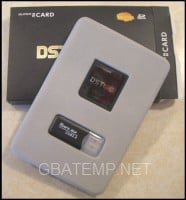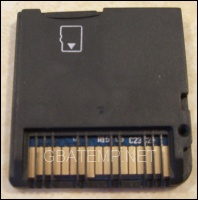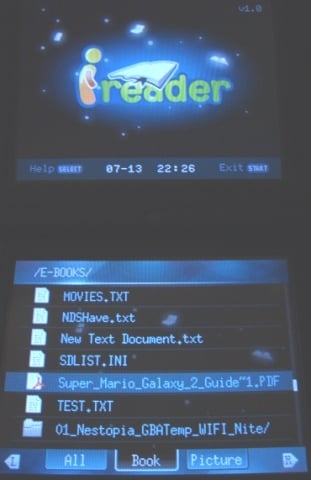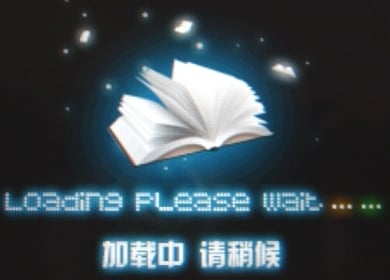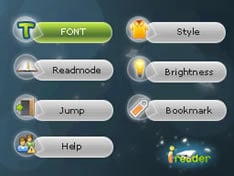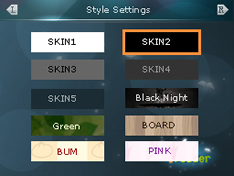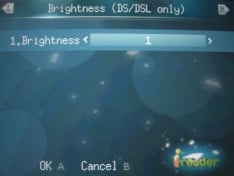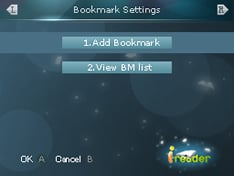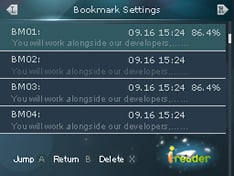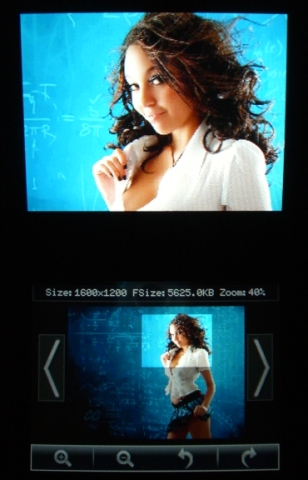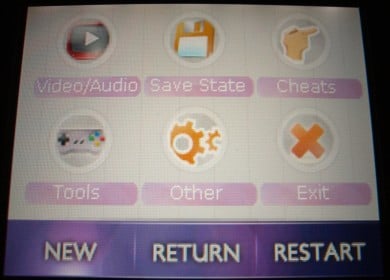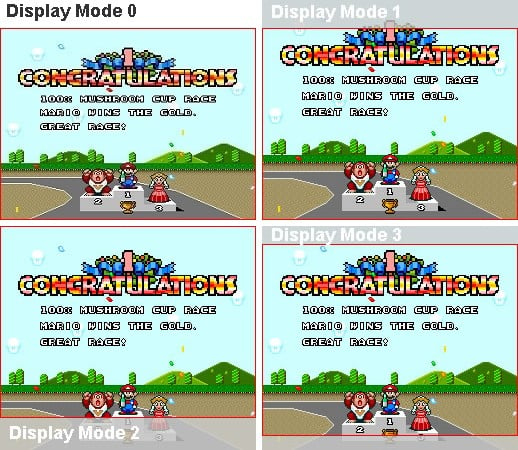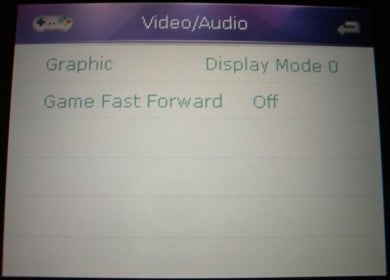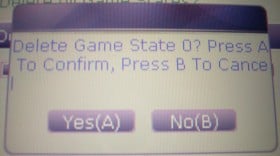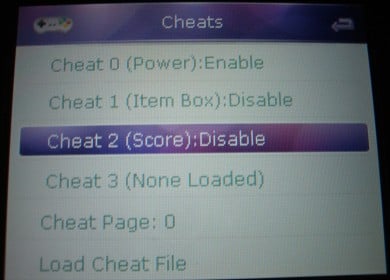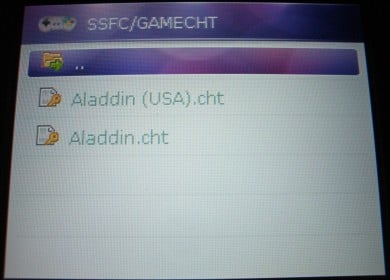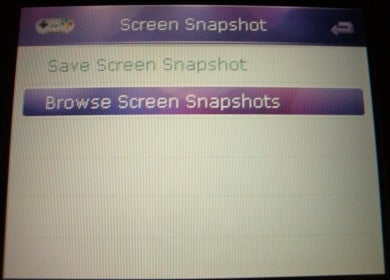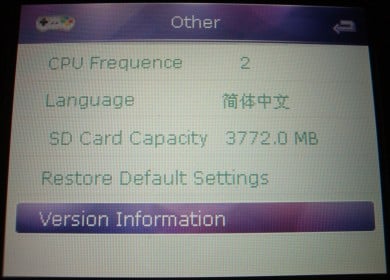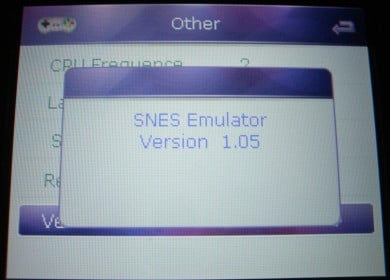- Joined
- Jan 3, 2008
- Messages
- 10,579
- Trophies
- 2
- Age
- 48
- Location
- From Where???
- Website
- wiki.gbatemp.net
- XP
- 5,535
- Country

<center><iframe src="http://shoptemp.net/viewproduct.php?pid=97" width ="100%" height="260" frameborder="0" allowtransparency="true"></iframe></center>
<font color="red">GBAtemp.net review of the...</font>
<font size="5"><font color="#000080">SuperCard DSTWO</font></font>

Manufactured by: SuperCard
Also Known As: SuperCardDS2, DSTWO, DS2, SCDSTWO, SCDS2
Review by Another World - completed 6/09/10
Review Contents & Index:
The SuperCard DSTWO (SCDS2), released by Team SuperCard, has been dubbed the 2nd generation of DS Slot-1 Flash Kits. Since the introduction of Slot-1 Flash Kits, users have continually desired new features, better support, and advancements from the developers. The SCDS2 attempts to appease the user with an on-board CPU capable of GBA Slot-1 emulation. Team SuperCard has additionally promised SNES emulation, drag/drop video playback, on-the-fly anti-piracy advancements, an in-game menu system, slow-motion, soft-reset, a real-time cheat editor, and more.
This review will focus on the current DSTWO EOS v1.02 firmware and its features. Features not currently available will be mentioned and discussed based on publicly available information. The review kit will be tested on a DSi XL and a 2 GB Japanese Kingston microSD card. NDS compatibility will be tested with both NDS Homebrew and NDS ROMS and the GBA EMU will be tested with both GBA Homebrew and GBA ROMs. All review photos will be taken using the “SILVER” EOS v1.02 included theme.
Official Features List (Corrected):
The list includes the phrase “unlimited microSD storage space support,” a selling tactic lie for which I have no appreciation. The included paper manual has an image of a microSD card and the box includes the phrase “SDHC” and a printed SDHC logo. This card clearly only supports SDHC external media, and as consumers we know that the limitation of SDHC cards is 32 GB.
The list mentions SNES emulation, something which has not yet been implemented by Team SuperCard or the EOS Operating System.
E-book support includes a listing of mostly image formats and skips some dedicated E-book formats (.EPUB, .LIT, .LRF, .MOBI, etc). I would have preferred that the image formats were listed under an appropriate Image heading and for .TXT and .PDF to remain under the E-book heading.
The feature list lacks any mention of video/multimedia formats. The card was publicized as supporting drag/drop video codec playback. This is another feature not yet implemented by Team SuperCard or the EOS Operating System.
Oddly there is no mention of the “plug-in” system for creating custom icons used as launching points for NDS Homebrew and NDS ROM files. This is an interesting feature which not only helps organization through a favorites list but provides a way for users to personalize their theme.
<div class="reviewbreak">Contents and Packaging</div>
Contents:
The SCDS2 ships in thin matte black colored cardboard box. The box measures approximately 5 and 1/2 inches by 3 and 3/4 inches by 3/4 of an inch. The left and right sides of the box fold inwards and secure with a cardboard flap. The box is printed with the “SuperCard” logo on all sides but the bottom. The top of the box includes a shiny DSTWO logo, a SuperCard Team logo, and a SDHC logo. The bottom of the box includes 3 shiny firmware screen captures of the EOS software. Also found on the bottom of the box is the official “Engrish” features listing and an official SuperCard URL (www.supercard.sc).
The box protects a thin plastic felt covered tray which slides in snugly and holds the SCDS2 and the microSD reader. Both of these items sit tightly into their respective cutouts, so well are they contained that users have reported damaging the shell of their SCDS2 while attempting to remove it. Removing either item is a simple as pulling out the tray and pushing on the back side to allow the item to lift away from the packaging. Under this tray sits the paper user manual and leather wrist strap. The wrist strap was not initially available for pre-ordered kits and later SCDS2 offered the strap as an additional purchase for resellers, causing each reseller to manually insert the wrist strap into each box. As a result of this some users have purchased a SCDS2 and not received the wrist strap, thus making it optional for the reseller and a random bonus for the buyer.
The included microSD reader measures approximately 1 and 3/4 of an inch by 5/8ths of inch by 2/8ths of an inch. The black colored plastic shell feels smooth and sturdy to the touch. The USB connector is protected by a clear plastic cover which slides and locks into the plastic shell. If the cover is reversed it will not lock shut and should not be forced. This microSD reader is a functional alternative and a nice addition to the internal packaging contents, however, it is much larger than my preferred solution and from a generic manufacturing factory. The longevity of this microSD reader based on build quality alone seems fairly long, yet only time will tell.
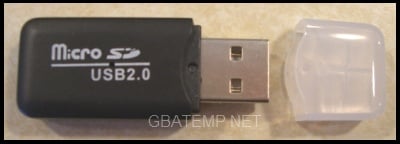
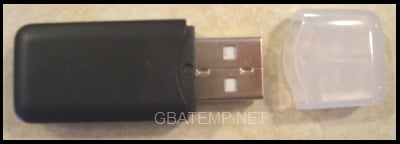 <div class="reviewbreak">Kit Design and Impressions</div>
<div class="reviewbreak">Kit Design and Impressions</div>
The SCDS2 uses a modified shell possibly based on the AK2i design, and at first glance they look almost identical except for a deeper shade of black and additional insertion guides. Instead of glue, the SCDS2 is held together by a single jewelry sized micro screw and 4 plastic raised inserts. The plastic inserts extend from the stickered back side of the kit and join into matching holds on the opposite side. The entire kit can be pried apart at every point but the lower right hand area surrounding the micro Phillips head screw. The back side of the PCB which contains the main chip is held fast to the shell thanks to the residue of the stickered label. The microSD slot is located on the left hand side of the SCDS2. The PCB has 17 connection teeth and 10 plastic guide points. The kit itself measures approximately 1 and 2/8th inches by 1 and 1/4 inches by 1/8 of an inch.
The SCDS2 feels relatively sturdy yet not so well secured. It is much too easy to separate the shell halves from one another. The bottom of the PCB is flat against the shell resulting in optimal contact with the NDS Slot-1 connection teeth. The addition of 10 plastic guides gives this card a slight connection advantage over other Slot-1 Flash Kits that I have used. The microSD slot aggressively grips the card and I find it difficult to remove the card at times from the SCDS2 shell. The spring loaded microSD slot feels as familiar as any Slot-1 spring loaded Flash Kit. This kit is relatively new I can not yet comment on the integrity of the spring. There is always the chance that the spring could fail, with moderate respected use I would expect the spring to last. The SCDS2 fits snug into the DSi XL and extremely tight into the NDS Lite. The card is difficult to remove from the NDS Lite due to the protruding chip and over extended stickered label.
The front side of the SCDS2 is protected only by the stickered label. It is very easy to see and feel the chips and the other distinct characteristics of the PCB. These parts are vital to the functionally of this kit and users should take caution to avoid pushing onto this area of the shell
Although I have actively sought out an official confirmation, user speculation is that the I-Player Flash Kit was also designed by Team SuperCard. Comparing both the I-Player and the SCDS2 together one will see the similarities between boxes, packaging materials, paper user manuals, shell designs, PCB designs, emulation software, features list, and more. If the I-Player was a testing ground for the SCDS2 I hope that Team SuperCard has learned their lesson and that the SCDS2 will not repeat the failures of the I-Player.
Team SuperCard has allowed their forum “Admin” to leak news of an official SCDS2 Software Development Kit (SDK). Software which will push this Flash Kit away from the competition must incorporate the onboard CPU and one can only dream of the emulation possibilities this card has in store. The future of this Flash Kit design could very well come down to the Homebrew community who may be powerless to do official plug-in compilations without the aid of Team SuperCard and the official SDK. Team SuperCard should begin offering free SCDS2 kits to any established Homebrew author who wishes to develop for this unique Flash Kit (AgentQ, Normmatt & Smiths, Moonlight, Rudolph, Flubba, Simon J. Hall, Alekmaul, etc). If you want to increase sales you need to offer a wide range of exclusive software option. This can be achieved by giving away a handful of SCDS2 Flash Kits along with the SDK to the right Homebrew community contributors. Nothing could come of this but the potential for SCDS2 greatness is worth the effort.
The community has put their faith and trust into Team SuperCard and software that does not perform as stated on the box or in pre-release news and publicized advertisements. However, SuperCard has always come from behind to offer support and features for the life of their products. While the initial impressions include disappointment the frequent updates and attempts to support the hardware should be noted.
<div class="reviewbreak">Set-up and Usage</div>
The SuperCard EOS v1.02 software is released archived with 4 main directories. These directories are “_dstwo”, “_dstwoplug”, “moonshl2”, and “NDSGBA”. Each of these 4 directories must be placed in the ROOT of a freshly formatted microSD card.
The “_dstwo” directory contains vital system related files, the User Interface theme files, and translated language .TXT files. Users can easily see the influence from the Ackeard R.P.G. software from which the EOS is based, by examining the familiar directory structure. The EOS themes are complex and made up of 54 files not including the additional patch and plug-in related theme files.
The “dstwoplug” directory contains EOS shortcut icons commonly called “plug-ins” based on this directories name and not on their actually functionality as external software applications. Each shortcut includes a correctly formatted .BMP image and an .INI file. The .INI file contains a path to the icon file and the name as displayed in the EOS software. The .NDS file itself must also be located in this directory and named the same name as the .BMP and .INI files.
The following is an examination of the included “MoonShell2” shortcut found in the EOS v1.02 default file structure.
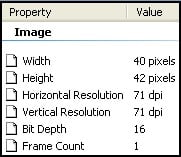
<p>Additional Plug-in Information:
 http://gbatemp.net/t229551-scds2-plugins
http://gbatemp.net/t229551-scds2-plugins
</p>
The “moonshl2” directory contains the default files found in a normal Moonshell v2.10 installation.
The “NDSGBA” directory contains all required files for the Slot-1 based GBA emulator. The EOS GBA EMU v1.21 install defaults on each load to this internal directory. Placing .GBA Homebrew files and .GBA retail ROM dumps into the “gamepak” directory will increase organization and minimize search time.
The file structures for the 3 firmware specific directories are as follows:
Like the Acekard R.P.G. firmware it is based off of, the EOS software uses a globalsettings.ini file to store various important system related variables. The default file stores many different options than the Acekard firmware. Please be cautious as editing the file directly is recommended for advance users.
<p>SCDS2 DLDI File:
 Download 1.05 KB
Download 1.05 KB
</p>
The EOS software is largely undocumented and unsupported for its current stage of development. Users are encouraged to do their own research until this Flash Kit is more efficiently documented. At such a point I will adjust this section of the review to reflect more factual content as I do not want this section to include research based on speculation.
EOS G.U.I.:
The SCDS2 will not skip the NDS firmware’s Health and Safety screen, user must click to advance or wait for this screen to time out. The current v1.04 SCDS2 firmware displays as “Fish Tycoon,” the v1.05 firmware is available but untested for this review. User reports have flooded the SuperCard forums with information about bricked or damaged SCDS2s after the v1.05 firmware upgrade. The v1.05 firmware upgrade is for users who auto-boot their NDS firmware and experienced problems with the SCDS2. This compatibility issue was limited to a handful of cards making the upgrade not advisable at this time.
Once the boot-up sequence is triggered the SCDS2 will load the EOS software in under 3 seconds. The EOS software has a similar design to the NDSi official firmware; the main screen contains various icons, the date and time, and a slider bar at the bottom. The top screen of the EOS software displays a still image with the text “It’s Time To Go Beyond DS.” At any point the B button can be pressed in succession to navigate the G.U.I. back to this top menu icon-display screen.
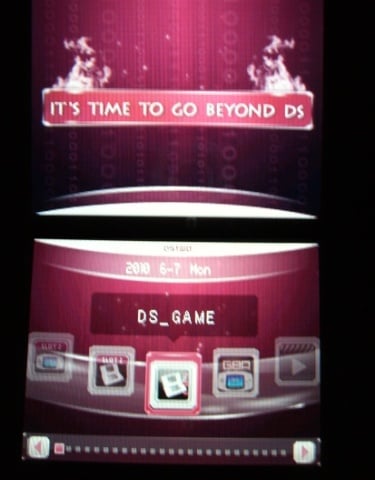 The default SuperCard EOS software comes pre-installed with a handful of icons. The included icons are “DS_GAME”, “SLOT2 NDS”, “SLOT2 GBA”, “MoonShell”, and “GBA Emulator”. The first 3 listed icons will boot .NDS files, PassME mode, or Slot-2 Expansion devices, respectively. The last two icons will boot MoonShell or the SCDS2 GBA EMU, these icons are user created and stored in the “./_dstwoplug” directory. Users can alter, rename, or remove various icons from the EOS software. The "DS_GAME" icon can only be renamed by hex-editing the “dstwo.nds” file found in the “_dstwo” system directory. This icon is part of the software and can not be removed.
The default SuperCard EOS software comes pre-installed with a handful of icons. The included icons are “DS_GAME”, “SLOT2 NDS”, “SLOT2 GBA”, “MoonShell”, and “GBA Emulator”. The first 3 listed icons will boot .NDS files, PassME mode, or Slot-2 Expansion devices, respectively. The last two icons will boot MoonShell or the SCDS2 GBA EMU, these icons are user created and stored in the “./_dstwoplug” directory. Users can alter, rename, or remove various icons from the EOS software. The "DS_GAME" icon can only be renamed by hex-editing the “dstwo.nds” file found in the “_dstwo” system directory. This icon is part of the software and can not be removed.
 <p>Hexing “DS_GAME”
<p>Hexing “DS_GAME”
• Open the dstwo.nds file into a hex-editor
• Browse for 0x00031a08 (bytes 08 to 0E)
• The replacement string can only be 7 characters in length
</p>
The “DS_GAME” icon boots into a second viewing area which sorts by default visible folders, and files with the .NDS extension. Non-visible folders with their attributes set to “hidden” can only be made visible by using your computer Operating System. Automatically sorting the display based on file extensions is a nice addition which keeps miscellaneous files hidden regardless of their attribute or association. However, users who wish to have more control over their files can additionally sort by NDS & SAV, GBA & SAV, or by ALL file types. The start menu can be displayed by pressing START or by clicking Start on the touch-screen. This menu can be further expanded by pressing RIGHT or A, and retracted by pressing LEFT or B. The top screen displays a clock, the currently browsed file or type (folders display as “folder”, files display using their internal information and icon), and the file name which is limited to 14 characters.
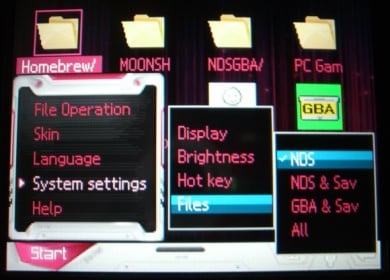
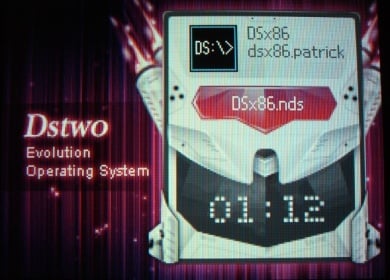 The Start menu provides the user with a minimalistic approach to firmware/software manipulation. As a result the EOS software has less of a learning curve but provides fewer options for tweaking the end experience. This experience is unlike the AKAIO firmware, where many options can be tweaked thus increasing the compatibility of the firmware and ROM files. The EOS user must rely on the SuperCard team for improvements, fixes, compatibility updates, and more.
The Start menu provides the user with a minimalistic approach to firmware/software manipulation. As a result the EOS software has less of a learning curve but provides fewer options for tweaking the end experience. This experience is unlike the AKAIO firmware, where many options can be tweaked thus increasing the compatibility of the firmware and ROM files. The EOS user must rely on the SuperCard team for improvements, fixes, compatibility updates, and more.
The start menu offers basic file operations including copy, cut, paste, and delete. These options are limited to 1 file type at a time; a .SAV file can not be moved or removed at the same time as an .NDS file, for example. The second start menu option provides a way for users to select skins found in the “./_dstwo/ui” directory. The default EOS v1.02 install includes the English, Chinese, French, Italian, German, Spanish, and Korean languages. Languages can be quickly and easily set through the start menu language area. The systems settings provide options for adjusting the display (icon or list), the brightness level (NDS Lite only, 1-4), the hotkey (.NDS retail ROM dumps' in-game menu key combination), and the previously discussed file display (NDS, NDS & SAV, GBA & SAV, ALL). The last start menu option displays a help menu which provides basic navigation information and the current EOS build number.
The currently implemented in-game menu functionally is limited to .NDS retail ROM dumps, Homebrew files are not supported. However, as of EOS v1.02, any Homebrew file capable of executing the “reset2desktop.nds” can soft-reset back to the main EOS icon display screen without accessing the in-game menu. The problem with this design is that older Homebrew files may be forgotten projects which will never be recompiled to access this .NDS soft-reset method. The .NDS retail ROM in-game menu button combination is completely configurable in real-time from within the key combination window.
The bottom right area of the tool bar contains 3 icons. The light build icon can adjust the backlight setting of the NDS Lite and the arrow back icon will navigate back one directory.
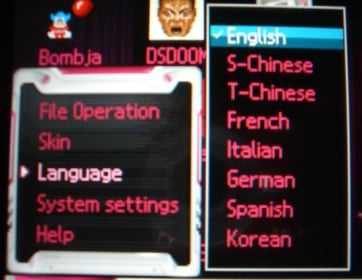
 The EOS software offers an icon based view and a list based view. The icon based view can display 12 items on the screen while the list based view can display 4 items on the screen. Both views display an icon and the file name, however, the icon based view truncates the file name between 6-8 characters when not highlighted and between 11-13 characters when highlighted. The list based view truncates the file name at 30 characters when highlighted and 32 characters when not highlighted.
The EOS software offers an icon based view and a list based view. The icon based view can display 12 items on the screen while the list based view can display 4 items on the screen. Both views display an icon and the file name, however, the icon based view truncates the file name between 6-8 characters when not highlighted and between 11-13 characters when highlighted. The list based view truncates the file name at 30 characters when highlighted and 32 characters when not highlighted.
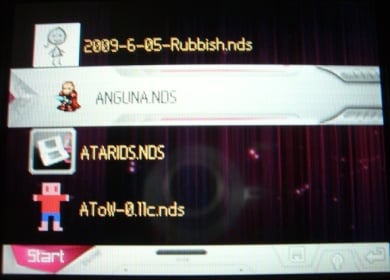
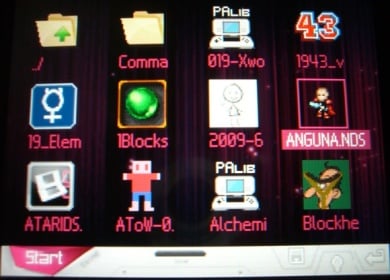 Once a file is highlighted execution can begin by either clicking on the file icon or by pressing A while in the icon list view. When using the list view, execution can begin by either clicking to the left of the icon or by pressing A. Loading beings with an EOS splash screen and can range anywhere between 2-30 seconds depending on the file. All .NDS retail ROM dumps load between 2-4 seconds, where some Homebrew projects took as long as 30 seconds to initialize (IE: Dawn Seekers).
Once a file is highlighted execution can begin by either clicking on the file icon or by pressing A while in the icon list view. When using the list view, execution can begin by either clicking to the left of the icon or by pressing A. Loading beings with an EOS splash screen and can range anywhere between 2-30 seconds depending on the file. All .NDS retail ROM dumps load between 2-4 seconds, where some Homebrew projects took as long as 30 seconds to initialize (IE: Dawn Seekers).
The in-game menu can be accessed by entering the user-submitted control sequence. The in-game menu, as previously stated, only functions with .NDS retail ROM dumps. Once the key combination is pressed the users is presented with options to reset back to the top EOS menu, open a gaming guide (.TXT, .BMP, .JPG), enter cheat codes (usrcheat.dat), save/load save-states, initialize slow-motion (0%, 25%, 50%, 75%, 100%), or access the on-the-fly “free cheat” engine. Most selection can be manipulated with either the touch screen or a combination of the D-pad and buttons. The B button will exit out of any menu and go back one level, the top most level being the game itself. The only way to soft-reset back to the EOS top menu is by clicking on to top left icon, there is no button combination for this menu option.
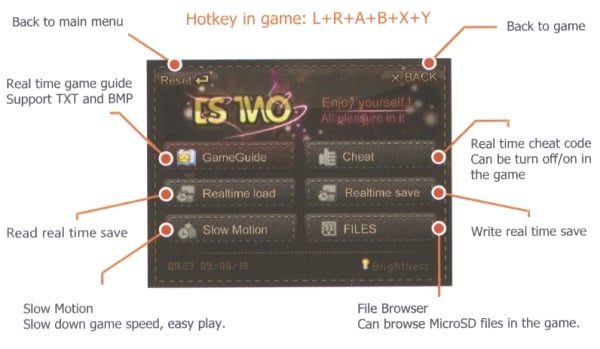
The top left icon allows the SCDS2 to soft-reset back to the top EOS menu. This icon can not be accessed using any D-pad or button combinations and requires the user to physically press the touch-screen to activate it. The top EOS menu holds user created shortcut icon “plug-ins”, Slot-2 booting options, etc. Users who wish to continue playing .NDS Homebrew or retail ROM dumps will need to select the “DS_GAME” icon following each soft-reset, something which quickly becomes an annoyance.

“Game guides” must be placed in the same directory as the .NDS retail ROM dump and given the same name. (IE: 0142 – Metroid_Prime_Pinrball.txt). The included literature states that .JPG and .BMP (24bit) are usable guide formats, however it appears that .JPG is not currently supported. Multiple guides can be hosted in the same directory by adding increasing single trailing digits to the file name. Users can also mix .TXT and .BMP guides into the same directory without the trailing digit.
<p>In-game Guide Examples Names:
0142 – Metroid_Prime_Pinrball.1.txt
0142 – Metroid_Prime_Pinrball.2.txt
0142 – Metroid_Prime_Pinrball.3.bmp
0142 – Metroid_Prime_Pinrball.1.txt
0142 – Metroid_Prime_Pinrball.2.txt
0142 – Metroid_Prime_Pinrball.bmp
0142 – Metroid_Prime_Pinrball.1.bmp
0142 – Metroid_Prime_Pinrball.2.bmp
</p>
Once the .TXT guide is loaded the text will display using a golden font color on a darker background, which I found very easy to read in both light and dark settings. Text based guides can be scrolled up or down by using the D-pad, with left or right acting as quick-skip keys. Image based guides can be scrolled right-left and top-bottom using the D-pad. The EOS software will store the X and Y coordinates of the last viewed image based guide, subsequent viewings will resume at the previous coordinates making image based map viewing easier to pick back up. Pressing B will exit out of the current window and go back one menu level.

The EOS software offers 4 slots to save and load “save-states” to and from. Pressing A on any of the 4 available save slots will create an .RTF* file in the game's directory, save-states made by pressing A will be named by the current date and time within the EOS software. Pressing X on any of the 4 available save slots will present the user with a keyboard, which can be used for entering custom save-state names made up of alphanumeric characters with no spaces. Selecting “OK” will exit out of the keyboard window and back into the current .NDS retail ROM dump. Loading a save-state is executed by Pressing A on any of the available save slots, loading a save-state will exit out of the “loading” window and back into the current .NDS retail ROM dump. Pressing B will exit out of the current window and go back one menu level.
The .RTF* file is created using a increasing numerical value, where 0 is save slot 1 and 1 is save slot 2, etc. Save-states made using the keyboard will contain the user created save-state name before the .RTF* file extension.
<p>.RTF* File Example:
• 4679 - Space Invaders Extreme 2 (U)_BOSS4.rtf0
• 4679 - Space Invaders Extreme 2 (U)_.rtf1
</p>
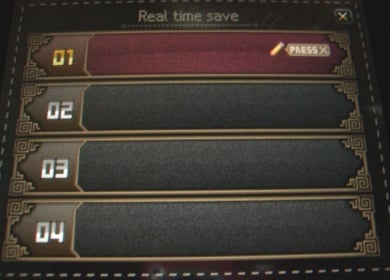
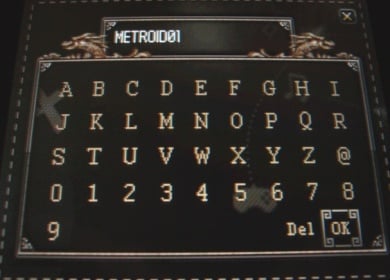

“Slow motion” presents the user with the ability to slow down the game play between 0% and 100%. The 100% option is not a true 100%, as the game play does not come to a stop, and it would be easier to think of the settings as 4 speed choices instead of percentages of speed. Upon exiting this window users will be presented with the option to save or cancel the current level setting. Pressing B will exit out of the current window and go back one menu level.
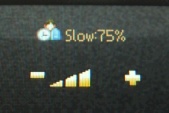

The “cheat code” option presents the user with selectable cheats from a properly formatted usrcheat.dat file. The usrcheat.dat file must be placed into the “./_dstwo” directory. The cheat menu can be accessed using a combination of the D-pad and buttons, or by using the touch-screen controls. Cheats can be checked on or off, and the entire selection screen can be cleared by clicking on the top right “clear all” icon. The cheat database can be scrolled up or down by using the D-pad, with left or right acting as quick-skip keys. However, the cheat names themselves can not be scrolled causing any text longer than 39 characters to be truncated. Multi-grouped cheats can be expanded by clicking on the “+” symbol or by pressing A, however, there are no touch screen controls for navigating back 1 level. Pressing the A button turns cheats on or off, and pressing the B button will exit out of the cheats menu and into the current .NDS retail ROM dump. Entering the cheat menu for a second time, if no cheats are altered, the pressing of B will go back 1 menu level instead.
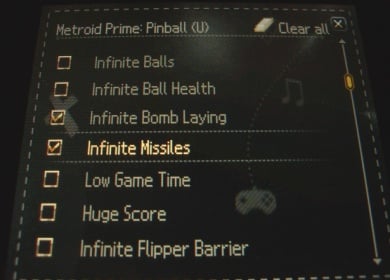

Recent .NDS retail ROM dumps which do not contain usrcheat.dat entries will benefit from the “free cheat” mode. Using this mode the user can compare and adjust game values, find and modify cheats, hacks, and more. The “free cheat” mode provides users with the ability to search values and to organize discovered cheat or hacks.
<p>Additional Information by Matt140:
1. Use the fuzzy search "equal" mode.
2. Create a save-state for the ROM.
3. Narrow the results by using > or <.
4. If a wide range of results are displayed, load the save-state.
5. Then perform another search to narrow the results even further.
If you are playing a game that has health which decreases, for example, you run fuzzy search on equal mode to get the initial values. After the search is performed you make a current save-state for the ROM. Resume the game and when the character’s health decreases load and use the fuzzy search mode once again. Set the compare type to “less than” to find all values that have decreased from the previous search. Continue to perform these steps until only a few results remain as the character is beginning to run low on health. Finally load the save-state and then search for values that have increased using the “more than” mode. Only the values which you have previously found, and which have now increased due to loading the older save-state, will be displayed. These values are the potential location of the character’s health level.
</p>
<p>Guides by elixirdream:
 SuperCard Forum How-to Guide by elixirdream
SuperCard Forum How-to Guide by elixirdream
 GBATemp Forum How-to Guide by elixirdream
GBATemp Forum How-to Guide by elixirdream
</p>
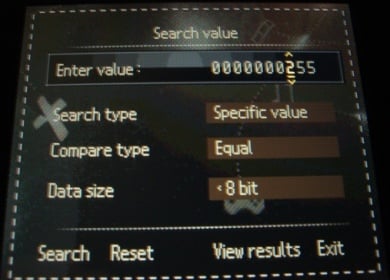
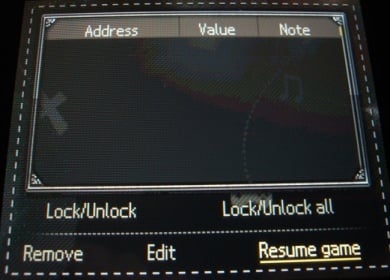 GBA EMU:
GBA EMU:
The SCDS2 GBA EMU is launched by pressing A on the main menu's GBA default plug-in icon. This icon executes the GBA.plg file found in the “_dstwoplug” directory.
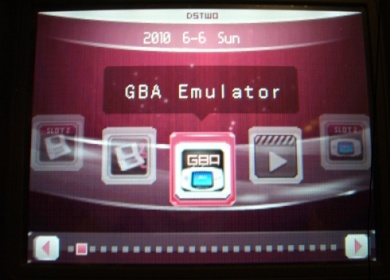 The GBA EMU will load approximately 6 seconds after the loading process has been initialized. Users are initially presented with a “no game loaded!” message on the top screen and an icon based file system on the bottom screen. The v1.21 software revision features 6 icons and 3 buttons. The icons read “video/audio”, “save state”, “cheats”, “tools”, “other”, and “exit”, and the buttons read “new”, “restart”, and “return”.
The GBA EMU will load approximately 6 seconds after the loading process has been initialized. Users are initially presented with a “no game loaded!” message on the top screen and an icon based file system on the bottom screen. The v1.21 software revision features 6 icons and 3 buttons. The icons read “video/audio”, “save state”, “cheats”, “tools”, “other”, and “exit”, and the buttons read “new”, “restart”, and “return”.
 The “video/audio” options are game fast-forward (off/on), frame skip type (auto/manual), frame skip level (0-9), and sound switch (on/off).
The “video/audio” options are game fast-forward (off/on), frame skip type (auto/manual), frame skip level (0-9), and sound switch (on/off).
Game fast-forward works just like it sounds. Once it is turned on and the game is resumed, the game will fast forward approximately 10 frames per second. This can be used to skip annoying long intros or lengthy sections of text in previously played titles.
Frame skip is a necessary evil for most GBA retail ROM dumps, and yet appears to do nothing to enhance GBA Homebrew titles. Leaving the Frame skip on “auto” had the best results for a large percentage of tested GBA retail ROM dumps.
Each setting in this menu must be set on a per-file basis, and the loading or unloading of each file resulted in these settings returning to their default levels.
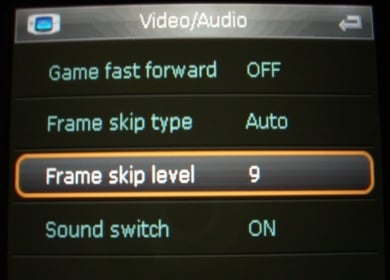 The “save state” selection offers the user options to save, load, and delete save-states. Each .GBA file can have a total of 10 save-states at any one time. Save-states are stored in the “./NDSGBA/gamerts” directory and indexed by a trailing number which is directly associated to the save-state menu position. When a save-state is present, the icon box will be filled in and the top screen will display a screen capture of the game taken when the save-state was initialized. Save-states can only be manipulated during the emulation of the associated GBA file.
The “save state” selection offers the user options to save, load, and delete save-states. Each .GBA file can have a total of 10 save-states at any one time. Save-states are stored in the “./NDSGBA/gamerts” directory and indexed by a trailing number which is directly associated to the save-state menu position. When a save-state is present, the icon box will be filled in and the top screen will display a screen capture of the game taken when the save-state was initialized. Save-states can only be manipulated during the emulation of the associated GBA file.
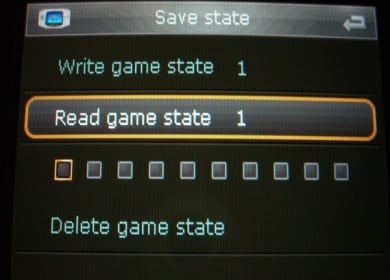 The “cheats” section manages GBA .CHT formatted cheat files. Users can load a total of 30 cheats (3 per 10 pages) for 1 cheat file. The cheat file is loaded into the EMU using the “load cheat file” button found at the bottom of this menu section.
The “cheats” section manages GBA .CHT formatted cheat files. Users can load a total of 30 cheats (3 per 10 pages) for 1 cheat file. The cheat file is loaded into the EMU using the “load cheat file” button found at the bottom of this menu section.
<p>.CHT Tool by Matt140:
• Add a game.
• Add cheats under a game (Action Replay/Gameshark codes supported).
• Edit/Delete cheats/games categories.
• Produce a compatible .CHT file.
 NDSGBA Cheat Maker 1.1 19.4 KB
NDSGBA Cheat Maker 1.1 19.4 KB
</p>
<p>Additional Information:
 How to make GBA cheats
How to make GBA cheats
</p>
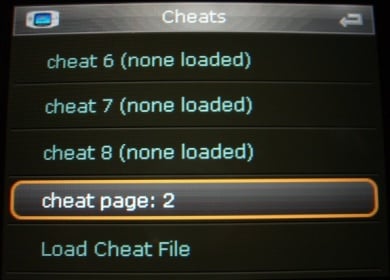 The “tools” section has options for screen snapshots (screen captures), key pad remapping, and a roll-back feature formally known as the “sands of time.” Screen snapshots can be taken or browsed, while browsing users can view a slide show of saved screen captures. Once a captured image is loaded it may remain on the screen during various other option setting and EMU tweaking. Screen snapshots are stored in the “./NDSGBA/gamepic” directory as a 112 KB 240x160 24 bit depth .BMP formatted file. The key pad remap area allows users to reassign the A and B buttons, as well as setting a Rapid Fire selection for each of these buttons. The roll-back feature will save and load a save-state between .2 and 10 seconds, and operates like a generic rewind feature allowing users the ability to cheat death. Once turned on the roll-back feature is accessed by pressing L+Y at the same time. This roll-back feature must be initiated on a per-file bases, as with all of the other EMU options and settings.
The “tools” section has options for screen snapshots (screen captures), key pad remapping, and a roll-back feature formally known as the “sands of time.” Screen snapshots can be taken or browsed, while browsing users can view a slide show of saved screen captures. Once a captured image is loaded it may remain on the screen during various other option setting and EMU tweaking. Screen snapshots are stored in the “./NDSGBA/gamepic” directory as a 112 KB 240x160 24 bit depth .BMP formatted file. The key pad remap area allows users to reassign the A and B buttons, as well as setting a Rapid Fire selection for each of these buttons. The roll-back feature will save and load a save-state between .2 and 10 seconds, and operates like a generic rewind feature allowing users the ability to cheat death. Once turned on the roll-back feature is accessed by pressing L+Y at the same time. This roll-back feature must be initiated on a per-file bases, as with all of the other EMU options and settings.
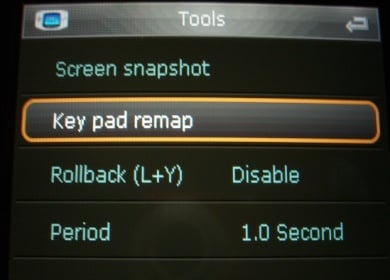
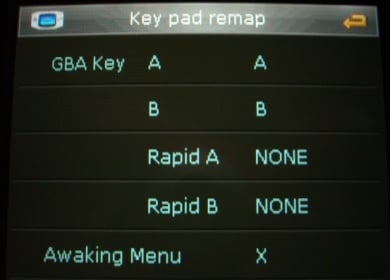
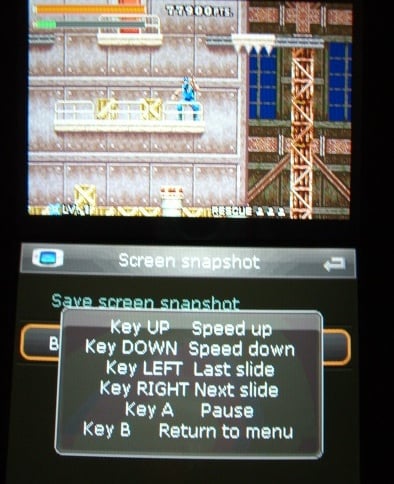 The “other” selection allows users to adjust the CPU frequency (1, 2, 3, 4), change the GBA EMU G.U.I. language, view the free space of the microSD card, initialize default settings, and view the version information (version/revision number).
The “other” selection allows users to adjust the CPU frequency (1, 2, 3, 4), change the GBA EMU G.U.I. language, view the free space of the microSD card, initialize default settings, and view the version information (version/revision number).

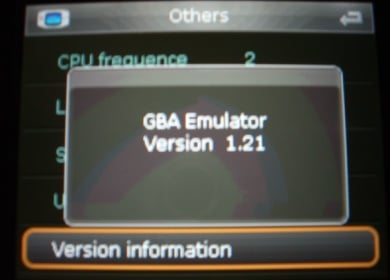 The “exit” icon will soft-reset out of the GBA EMU and back into the EOS top menu icon based "plug-in" display.
The “exit” icon will soft-reset out of the GBA EMU and back into the EOS top menu icon based "plug-in" display.
The “new” button opens a window for browsing .GBA files, users can browse from a list of new files or recently played files. The “new games” option will open the “./NDSGBA/gamepak” directory by default, with the added option to browse the entire microSD card. To speed up game selections it is advisable to store your .GBA files into this directory, although this is not a requirement. The “latest recently played games” option will sort by a list of recently accessed files regardless of their current availability on the microSD card. Files can load using the most recent save-state, allowing users to pick up exactly where they left off. Users who wish to use this option are encouraged to make a save-state before taking a file execution break.
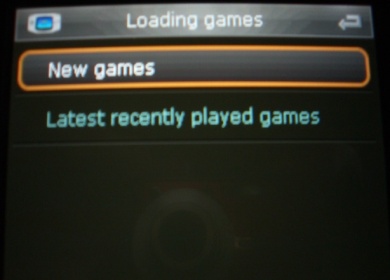
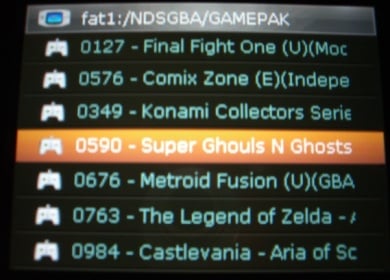 The “restart” button will soft-reset a .GBA file and reload it for emulation. The “return” button resumes the current emulation; after any options are adjusted this button or the B button are required to implement those changes. Making system adjustments (frame skip, etc) and reloading a .GBA file will result in those adjustments being changed back to the default settings. The B button will go back one directory listing for most menus, however, during game selection the B button will go back one directory listing into the microSD card. In the game selection menu pressing Y will return the software back to the top menu. Users should be aware that the SCDS2 GBA EMU features no touch sceen controls of any kind.
The “restart” button will soft-reset a .GBA file and reload it for emulation. The “return” button resumes the current emulation; after any options are adjusted this button or the B button are required to implement those changes. Making system adjustments (frame skip, etc) and reloading a .GBA file will result in those adjustments being changed back to the default settings. The B button will go back one directory listing for most menus, however, during game selection the B button will go back one directory listing into the microSD card. In the game selection menu pressing Y will return the software back to the top menu. Users should be aware that the SCDS2 GBA EMU features no touch sceen controls of any kind.
<div class="reviewbreak">SCDS2 EOS Features</div>
Many planned features have yet to be released for the EOS software, and some have already been implemented to a less than desirable level of functionality and compatibility. The following is a listing of the features which were either mentioned during press releases or as hype from the original team.
Present Features:
The in-game menu functions as expected on a majority of NDS retail ROM dumps, however, in some cases the menu fails to load. More recent game dumps suffer from a “black line” flickering of the in-game menu itself, making it difficult to pick options base purely on sight. The in-game menu is limited to NDS retail ROM dumps and will not function on NDS Homebrew files. I would not expect all options to work with Homebrew files, however, save-states and in-game guides would be a wonderful addition for supported Homebrew files.
In-game guide supports .TXT and .BMP files. The .BMP image files must be saved with a 24-bit depth.
Slow-motion works on a majority of files with varied results. For the majority of files this feature works as expected and can be adjusted in real time. However, with some files this feature causes graphical bleeding, layering issues, and other similar problems.
Automatic DLDI patching works in most cases but has some problems. Some NDS Homebrew projects will only be patched if launched directly from their microSD card directory, attempting to launch the same file through the shortcut icon “plug-in” feature will result in a failed DLDI patch.
On-the-fly anti-piracy (AP) patching appears to function correctly. However, some users have reported AP patch failure.
Slot-1 GBA Emulation is functional while being extremely buggy. Many GBA Homebrew files failed to function correctly with the EMU. In addition to Homebrew, GBA retail ROM dumps have also failed by causing the emulator to crash. The emulator experiences sound problems, graphical issues, faster than expected emulation, and Homebrew menu accuracy inconsistencies.
The EOS software is incredibly customizable though user made G.U.I. themes. The software contains so many images that the SCDS2 community is currently guessing at the purpose of some images.
The icon and list based view modes are limited by the amount of text each mode allows. The icon mode uses extremely large icons allowing for only 4 files to be listed at one time. Neither mode incorporates any text scrolling; names which are too long are simply truncated.
The SCDS2 is fully updatable in the event of a future official DSi block. The current v1.04 firmware suffers from a NDS Lite auto-boot incompatibility. Team SuperCard released a v1.05 firmware to address this problem. However, the recent firmware update has been reported to render some cards useless.
<div class="reviewbreak">Performance</div>
GBA Homebrew and GBA retail ROM dumps were tested on a DSi XL using a 2 GB Japanese Kingston microSD card formatted with the Panasonic Formatting Tool. Various features of the SCDS2 GBA EMU were tested at random to determine their efficiency. The GBA EMU v1.21 was used for all testing along with the gpSP "game_config.txt" file.
Each result is listed below by Homebrew or ROM name followed by a color coded phrase. Green colored phrases mean the file performed as expected with no problems. Blue colored phrases mean the file performed with some problems. Problems could include speed issues, compatibility problems, graphical issues, sound distortion, etc. A generalized listing of encountered problems will be added next to each appropriate section. Red colored phrases mean that the file failed. Failed files were additionally tested on a GBA PC Emulator.
I attempted to test the latest revisions of Homebrew projects. For popular Homebrew projects I tested the most downloaded revision and not the latest BETAs. In regards to GBA retail ROM dumps I tested only N. American dumps verified by CRC against the GBA Good-set listing.
GBA Homebrew Compatibility:
There are over 100 GBA Homebrew files worth having in any game collection. Some of the “commercial” quality offerings are completely unsupported by the SCDS2 GBA EMU. This is a serious fault of the code, one I hope they address in a future revision.
GBA retail ROM dumps have a higher compatibility rate. The list of known problematic files is far smaller than the list of known working files. Save files function as expected, even AKAIO saves stripped of their 16-byte header. Save-states work very well and caused no problems for the files this feature was tested on. Some games require frame skip to perform optimally, in these cases the best results were achieved by keeping the frame skip setting on “auto.” Some games were emulated much too quickly regardless of the frame skip level (IE: Doom). The Game Fast Forward option works wonderfully well and aided during the testing of some games with extremely lengthy intros (IE: Metroid Fusion).
Both GBA Homebrew and GBA retail ROM dumps compatibility is far from perfect and recent updates to the EMU have included only minor enhancements. The inclusions of a Real Time Clock and various G.U.I. improvements have been addressed over Homebrew and ROM capability. The SCDS2 GBA EMU is very usable in regards to GBA retail ROM dumps and at times enjoyable with GBA Homebrew. Users who are looking for the ultimate Slot-1 GBA solution may be disappointed, especially those who specifically enjoy GBA Homebrew.
The SCDS2 EMU is a port of the Dingoo GBA EMU which is a port of gpSP. Thanks in part to the Dingoo SDK gpSP was able to be ported to the I-Player and in turn compiled for the SCDS2. The ported gpSP EMU can utilize an external file called “game_config.txt”, a file which helps to tweak the emulators performance through the external manipulation of various EMU based variables and settings. The “game_config.txt” file should be placed into the NDSGBA ROOT folder, and will allow for many games, not officially supported, to play as expected. The Another World Homebrew file by Foxy has an entry in the “game_config.txt” file, and this file is required to get this exceptional commercial quality Homebrew port up and running. It begs the questions if other Homebrew files can be fixed by using this file, one can only hope that the Homebrew community will insert the correct lines of information into the "game_config.txt" file to help improve GBA Homebrew compatibility.
<p>Game_config.txt File Download:
 Download 5.94 KB
Download 5.94 KB
</p>
NDS Homebrew and ROMs were tested on a DSi XL/DS Lite using a 2 GB Japanese Kingston microSD card formatted with the Panasonic Formatting Tool. Various features of each Homebrew file were tested at random to determine their efficiency (saving, loading, mods, wads, etc). The SCDS2 EOS in-game menu options were tested at random on a grouping of NDS ROMs and no single ROM received testing of each possible option.
The results are listed below by Homebrew or ROM name followed by a color coded phrase. Green colored phrases mean the file performed as expected with no problems. Blue colored phrases mean the file performed with some problems. Problems could include speed issues, compatibility problems, graphical issues, sound distortion, etc. A generalized listing of encountered problems will be added next to each appropriate section. Red colored phrases mean that the file failed. Failed files were additionally tested on a NDS PC Emulator.
I attempted to test the latest revisions of Homebrew projects. For popular Homebrew projects I tested the most downloaded revision and not the latest BETAs. In regards to NDS retail ROM dumps I tested only good/clean dumps verified by CRC against the ADVANsCEne listing.
NDS Homebrew Compatibility:
Operation Libra has become my personal test file for Homebrew compatibility. The game was developed for a coding competition using a Flash Kit, yet it continues to fail on every kit I have tested it on. There was no surprise when it failed on the SCDS2, while the file continues to function correctly on NDS PC based emulation software.
The SCDS2 does not currently support Homebrew soft-reset, a feature which does exist on the SCDS1. Team SuperCard has instead implemented an .NDS file which can reboot the EOS firmware without a hard-reset, however this file can only be executed by Homebrew that can access it (IE: MoonShell).
Users have reported that some Homebrew files will not function on the DSi while the same files work as expected on the NDS Lite. Speculation for this failure does not include DLDI patching, but a SCDS2 DSi firmware incompatibility.
Retail NDS ROM dumps performed better than expected in regards to the tested files. On-the-fly anti-piracy (AP) patching appears to be working as publicized. However, some users have reported anti-piracy patching failure. Tested ROMs were played between 20 and 60 minutes, and the possibility remains that the affected AP areas were simply not experienced.
The in-game menu is somewhat buggy and fails to load on the occasional NDS retail ROM dump. In addition, some features do not perform as expected or cause graphical glitches. Save-states, cheats, and in-game guides performed without any compatibility issues.
In regards to Castlevania - Portrait of Ruin, the issue is coding based on the part of the developer. A patching method is required for this ROM to function correctly on any Flash Kit. Users who contest this statement are advised to research the AKAIO firmware fix for this known threading bug. This fix was added into the open-source R.P.G. firmware and later used by the most popular Flash Kit firmware solutions. I had assumed that Team SuperCard would have implemented this fix, and was disappointed to experience the infamous “freezing issue” on the SCDS2.
Over all, NDS retail ROM dump compatibility was very high, in regards to tested files, with various problems almost completely related to the in-game menu and its supported features.
<div class="reviewbreak">Conclusion</div>
The SCDS2 is a lesson for buying into the hype of pre-release information, advertisements, and official team comments. The card was publicized to contain SNES emulation and movie support, two features which did not make the release date. Users who preordered the card may have been disappointed by the buggy EOS software, lack of features, and poor build quality.
The SCDS2 was in development for a year and Team SuperCard has paid attention to the community. The SCDS2 offers many features that other development teams can not. The SCDS2 has recompiled the I-Player Homebrew GBA emulator, offering a GBA Slot-1 only solution for the NDS and DSi. The team promises SNES emulation to be released shortly with video support to follow soon after. Team SuperCard may not have been able keep up with the publicity and hype, but they are managing to release supported software updates.
Team SuperCard has always stuck by their products, they have continued to this day to support their cards, offer a forum where the community voice can be heard, and push the level of Slot-1 possibilities. The future for this card looks very bright as long as the team continues to actively support their product.
The SCDS2 has a below average build quality, with no clips, screws, or glue, around the outer edge, the card can easily be separated and possibly damaged. The most important elements of the SCDS2 (control chip, RAM chip, etc) are located under the sticker in a windowed shell, where little protection is provided for these hardware items. The spring loaded microSD slot is untested and the community does not yet know how well it will hold up.
The Current SCDS2 EOS v1.02 software is buggy and suffers from problems that occur randomly. The software has DLDI patching issues, DSi touch-screen incompatibilities, Homebrew compatibility issues, in-game menu bugs, NDS retail ROM dump incompatibilities, limited display issues, is lacking long file name scrolling, etc. The software is broken down into so many subfolders that it is hard to keep track of what everything is and why it needs to be there. The SCDS2 GBA EMU has very poor GBA Homebrew support, interface bugs, frame-skip inconsistencies, and other issues.
The SCDS2 EOS v1.02 software and its plug-ins are far from perfect, yet the average users will find a well thought out in-game menu that works a majority of the time, very high NDS Homebrew support, excellent NDS compatibility, fully customizable G.U.I. themes, and more. Users should understand that Team SuperCard is not a new team and they should have no problems working out the EOS kinks. There can easily be a fix for each software related bug or problem, we only need to report these issues and allow the team time to fix them.
The SCDS2 is packed with features that are a bonus for any Flash Kit hobbyist. The in-game menu allows the user to turn cheats on or off when desired, access 1 of 4 save-states, and play with other fun features like an in-game guide, slow-motion, and an on-the-fly cheat creation engine. Anti-piracy patching appears to be performing as expected, in regards to the tested files, and users have already started to use the phrase “it works on the SCDS2!”
Battery life of the SCDS2 is limited by what applications are running. With the GBA EMU on the 3rd DSi backlight setting I experienced approximately 3 hours of battery life. With other Flash Kit functions I experienced approximately 5 hours of battery life. The normal Slot-1 functions which users commonly use (NDS files, etc) received the same amount of battery life as other Slot-1 Flash Kits (IE: 5-7 hours).
I would rate the design of the shell at 4/10. The shell should have been better secured with a windowless design. However, the card is sturdy enough that adult users who respect their toys should not experience any issues with it. Based on the design alone I find it hard to recommend this card to younger gamers.
I would rate the EOS software with its known file compatibility, currently experienced bugs, etc at a 6/10. The software does more than other Slot-1 Flash Kits, yet the software is filled with bugs and inconsistencies which can negatively impact the end user’s experience. Once the EOS software is polished and the small issues have been addressed this score will change to an 8/10. For Team SuperCard to earn anything higher they need to better organize the directory structure, add D-pad and button navigation support for every EOS menu (soft-reset, “+” cheat expansion menus, etc), add Homebrew soft-reset support, add long file name scrolling support (for “NDS_GAME” and the cheat window), add Slot-2 PSRAM and SRAM options, and fix the current soft-reset to return to the directory last viewed.
Complaints and other issues listed in this review may seem minor to the average user, but after spending over 100 hours in the past 7 days with this Flash Kit I can already see the annoyances and problems that the moderate user may not experience for the next 2-3 months.
I find it hard to judge this Flash Kit by its current level of development. For Homebrew users this Flash Kit would receive a bronze award, due to missing features and DLDI support problems. For NDS retail ROM dump users this Flash Kit would receive a Gold award, due to AP patching, the in-game menu, and other exciting features. For GBA users this Flash Kit would receive a silver award, due to the buggy GBA EMU regardless of its uniqueness. Let us not forget the yet to be released SNES emulation and drag/drop video support. Both features have the possibility to fail on some level. These features were mentioned on the box and during official publicized advertisements, and so they should be considered towards the overall award.
Until Team SuperCard can iron out the bugs I can not pass judgment on this Flash Kit. After a year of development the SCDS2 should have shipped with fully debugged software, including all of the options on the box, etc. Team SuperCard is releasing updates and I want to provide for them the benefit of the doubt. Therefore, I will reserve a final award until each of the launch features has been released. I will cover the three missing launch features as GBATemp “mini” reviews sometime in the future. During which time Team SuperCard can work to debug the EOS software and included updated features, emulation, etc. After such a point I will reevaluate this Flash Kit and a final GBATemp award can be decided upon.
The EOS software is currently battling itself for the high ground. For each thing it does right a bug or other issue can be found. The SCDS2 has the potential to be one of the most memorable DSi compatible Flash Kits, a potential resting on shoulders of the EOS software. Time will tell if this card becomes a classic, I only hope bug fixes for this card are released sooner rather than later.
<font color="green">Pros:</font>
<font color="green">+</font> On-board CPU
<font color="green">+</font> microSDHC support
<font color="green">+</font> Free microSD reader
<font color="green">+</font> EOS is frequently addressed, updated, discussed
<font color="green">+</font> Nice clean interface
<font color="green">+</font> In-game menu (soft-reset, cheats, in-game guide, slow-motion, soft-reset, etc)
<font color="green">+</font> On-the-fly AP patching
<font color="green">+</font> Multi-language support
<font color="green">+</font> Action Replay cheat support
<font color="green">+</font> Clean ROM support, no patching required
<font color="green">+</font> Auto DLDI patching support
<font color="green">+</font> PassME functionality
<font color="green">+</font> Custom icon “plug-in” organizational support
<font color="green">+</font> Slot-1 GBA emulation solution
<font color="green">+</font> High NDS Homebrew compatibility
<font color="green">+</font> High NDS retail ROM dump compatibility
<font color="green">+</font> Updatable firmware
<font color="green">+</font> Official SDK (soon to be released)
<font color="green">+</font> Strong user community
<font color="red">Cons:</font>
<font color="red">-</font> Missing SNES emulation
<font color="red">-</font> Missing drag/drop video support
<font color="red">-</font> Missing E-book reader support
<font color="red">-</font> DLDI patching problems
<font color="red">-</font> Poor GBA Homebrew compatibility
<font color="red">-</font> GBA emulator is buggy
<font color="red">-</font> EOS v1.02 software is buggy
<font color="red">-</font> Some in-game menu options are buggy
<font color="red">-</font> Lack of Homebrew soft-reset support
<font color="red">-</font> below average build quality, shell is poorly secured
<font color="red">-</font> Soft-reset always returns to the top most menu
<font color="red">-</font> Lack of Slot-2 PSRAM and SRAM support
<font color="red">-</font> Lack of native Slot-2 flashing options
<div class="reviewbreak">
 >> AWARD -- Soon to be announced</div>
>> AWARD -- Soon to be announced</div>
Links:
Official Website
DSTWO F.A.Q.
SuperCard's Official Forum
GBATemp's SuperCard Forum
This review was written for GBAtemp.net ONLY. The article and included photos are the property of GBAtemp.net, except for the following. The SCDS2 PCB shots were provided by How_do_i_do_that. The SCDS2 manual scans were provided by Pong20302000. Research was conducted using the SC Forums, IRC, and the GBATemp SC Sub-forum.
Special thanks to Shaunj66, Costello, and the #acekard crew. Without all of you this review would not have been possible.
Special thanks to L551 for all of your help, forum linking, and information!
Special thanks to AbraCadvr for providing stuff that made this review possible.
Thanks to Vatoloco for additional GBA EMU testing.
Thanks to How_do_i_do_that for the PCB images and to Pong20302000 for the manual scans.
Thanks to Spikey, Matt140, CannonFoddr, Brien S., and Allustar for additional information.
Thanks to ShopTemp for providing the review sample!
Thanks to Jimi Hendrix for Valleys Of Neptune, the theme music for this review!
If you see this review on any other site please let Another World know by PM.[/plain]
<font color="red">GBAtemp.net review of the...</font>
<font size="5"><font color="#000080">SuperCard DSTWO</font></font>

Manufactured by: SuperCard
Also Known As: SuperCardDS2, DSTWO, DS2, SCDSTWO, SCDS2
Review by Another World - completed 6/09/10
Review Contents & Index:
- Review Introduction
- Official Features List - Contents and Packaging
- Kit Design and Impressions
- Set-up and Usage
- EOS G.U.I.
- GBA EMU - DSTWO EOS Features
- Present Features
- Missing Features - Performance
- GBA Homebrew Compatibility
- GBA ROM Compatibility
- NDS Homebrew Compatibility
- NDS ROM Compatibility - Conclusion
The SuperCard DSTWO (SCDS2), released by Team SuperCard, has been dubbed the 2nd generation of DS Slot-1 Flash Kits. Since the introduction of Slot-1 Flash Kits, users have continually desired new features, better support, and advancements from the developers. The SCDS2 attempts to appease the user with an on-board CPU capable of GBA Slot-1 emulation. Team SuperCard has additionally promised SNES emulation, drag/drop video playback, on-the-fly anti-piracy advancements, an in-game menu system, slow-motion, soft-reset, a real-time cheat editor, and more.
This review will focus on the current DSTWO EOS v1.02 firmware and its features. Features not currently available will be mentioned and discussed based on publicly available information. The review kit will be tested on a DSi XL and a 2 GB Japanese Kingston microSD card. NDS compatibility will be tested with both NDS Homebrew and NDS ROMS and the GBA EMU will be tested with both GBA Homebrew and GBA ROMs. All review photos will be taken using the “SILVER” EOS v1.02 included theme.
Official Features List (Corrected):
- Real time functions: real-time save, real-time game guide (txt, bmp, jpg), and real-time cheat.
- Multi-saves (up to 4 slots), easy to back-up and restore saves.
- Unlimited microSD storage space support. SDHC support. FAT or FAT 32.
- Multiple languages.
- Built-in GBA/SNES Emulator.
- Action slow motion (4 levels).
- File management system (copy, paste, cut, and delete). Long file name support.
- E-book in .BMP, .JPEG, .JPG, .PNG, .TIF, .GIF, .TXT, and .PDF formats.
The list includes the phrase “unlimited microSD storage space support,” a selling tactic lie for which I have no appreciation. The included paper manual has an image of a microSD card and the box includes the phrase “SDHC” and a printed SDHC logo. This card clearly only supports SDHC external media, and as consumers we know that the limitation of SDHC cards is 32 GB.
The list mentions SNES emulation, something which has not yet been implemented by Team SuperCard or the EOS Operating System.
E-book support includes a listing of mostly image formats and skips some dedicated E-book formats (.EPUB, .LIT, .LRF, .MOBI, etc). I would have preferred that the image formats were listed under an appropriate Image heading and for .TXT and .PDF to remain under the E-book heading.
The feature list lacks any mention of video/multimedia formats. The card was publicized as supporting drag/drop video codec playback. This is another feature not yet implemented by Team SuperCard or the EOS Operating System.
Oddly there is no mention of the “plug-in” system for creating custom icons used as launching points for NDS Homebrew and NDS ROM files. This is an interesting feature which not only helps organization through a favorites list but provides a way for users to personalize their theme.
<div class="reviewbreak">Contents and Packaging</div>
Contents:
- 1x SuperCard DSTWO
- 1x microSD reader
- 1x User manual (in "Engrish" and Chinese)
- 1x blue leather wrist strap
The SCDS2 ships in thin matte black colored cardboard box. The box measures approximately 5 and 1/2 inches by 3 and 3/4 inches by 3/4 of an inch. The left and right sides of the box fold inwards and secure with a cardboard flap. The box is printed with the “SuperCard” logo on all sides but the bottom. The top of the box includes a shiny DSTWO logo, a SuperCard Team logo, and a SDHC logo. The bottom of the box includes 3 shiny firmware screen captures of the EOS software. Also found on the bottom of the box is the official “Engrish” features listing and an official SuperCard URL (www.supercard.sc).
The box protects a thin plastic felt covered tray which slides in snugly and holds the SCDS2 and the microSD reader. Both of these items sit tightly into their respective cutouts, so well are they contained that users have reported damaging the shell of their SCDS2 while attempting to remove it. Removing either item is a simple as pulling out the tray and pushing on the back side to allow the item to lift away from the packaging. Under this tray sits the paper user manual and leather wrist strap. The wrist strap was not initially available for pre-ordered kits and later SCDS2 offered the strap as an additional purchase for resellers, causing each reseller to manually insert the wrist strap into each box. As a result of this some users have purchased a SCDS2 and not received the wrist strap, thus making it optional for the reseller and a random bonus for the buyer.
The included microSD reader measures approximately 1 and 3/4 of an inch by 5/8ths of inch by 2/8ths of an inch. The black colored plastic shell feels smooth and sturdy to the touch. The USB connector is protected by a clear plastic cover which slides and locks into the plastic shell. If the cover is reversed it will not lock shut and should not be forced. This microSD reader is a functional alternative and a nice addition to the internal packaging contents, however, it is much larger than my preferred solution and from a generic manufacturing factory. The longevity of this microSD reader based on build quality alone seems fairly long, yet only time will tell.


The SCDS2 uses a modified shell possibly based on the AK2i design, and at first glance they look almost identical except for a deeper shade of black and additional insertion guides. Instead of glue, the SCDS2 is held together by a single jewelry sized micro screw and 4 plastic raised inserts. The plastic inserts extend from the stickered back side of the kit and join into matching holds on the opposite side. The entire kit can be pried apart at every point but the lower right hand area surrounding the micro Phillips head screw. The back side of the PCB which contains the main chip is held fast to the shell thanks to the residue of the stickered label. The microSD slot is located on the left hand side of the SCDS2. The PCB has 17 connection teeth and 10 plastic guide points. The kit itself measures approximately 1 and 2/8th inches by 1 and 1/4 inches by 1/8 of an inch.
The SCDS2 feels relatively sturdy yet not so well secured. It is much too easy to separate the shell halves from one another. The bottom of the PCB is flat against the shell resulting in optimal contact with the NDS Slot-1 connection teeth. The addition of 10 plastic guides gives this card a slight connection advantage over other Slot-1 Flash Kits that I have used. The microSD slot aggressively grips the card and I find it difficult to remove the card at times from the SCDS2 shell. The spring loaded microSD slot feels as familiar as any Slot-1 spring loaded Flash Kit. This kit is relatively new I can not yet comment on the integrity of the spring. There is always the chance that the spring could fail, with moderate respected use I would expect the spring to last. The SCDS2 fits snug into the DSi XL and extremely tight into the NDS Lite. The card is difficult to remove from the NDS Lite due to the protruding chip and over extended stickered label.
The front side of the SCDS2 is protected only by the stickered label. It is very easy to see and feel the chips and the other distinct characteristics of the PCB. These parts are vital to the functionally of this kit and users should take caution to avoid pushing onto this area of the shell
Although I have actively sought out an official confirmation, user speculation is that the I-Player Flash Kit was also designed by Team SuperCard. Comparing both the I-Player and the SCDS2 together one will see the similarities between boxes, packaging materials, paper user manuals, shell designs, PCB designs, emulation software, features list, and more. If the I-Player was a testing ground for the SCDS2 I hope that Team SuperCard has learned their lesson and that the SCDS2 will not repeat the failures of the I-Player.
Team SuperCard has allowed their forum “Admin” to leak news of an official SCDS2 Software Development Kit (SDK). Software which will push this Flash Kit away from the competition must incorporate the onboard CPU and one can only dream of the emulation possibilities this card has in store. The future of this Flash Kit design could very well come down to the Homebrew community who may be powerless to do official plug-in compilations without the aid of Team SuperCard and the official SDK. Team SuperCard should begin offering free SCDS2 kits to any established Homebrew author who wishes to develop for this unique Flash Kit (AgentQ, Normmatt & Smiths, Moonlight, Rudolph, Flubba, Simon J. Hall, Alekmaul, etc). If you want to increase sales you need to offer a wide range of exclusive software option. This can be achieved by giving away a handful of SCDS2 Flash Kits along with the SDK to the right Homebrew community contributors. Nothing could come of this but the potential for SCDS2 greatness is worth the effort.
The community has put their faith and trust into Team SuperCard and software that does not perform as stated on the box or in pre-release news and publicized advertisements. However, SuperCard has always come from behind to offer support and features for the life of their products. While the initial impressions include disappointment the frequent updates and attempts to support the hardware should be noted.
<div class="reviewbreak">Set-up and Usage</div>
The SuperCard EOS v1.02 software is released archived with 4 main directories. These directories are “_dstwo”, “_dstwoplug”, “moonshl2”, and “NDSGBA”. Each of these 4 directories must be placed in the ROOT of a freshly formatted microSD card.
The “_dstwo” directory contains vital system related files, the User Interface theme files, and translated language .TXT files. Users can easily see the influence from the Ackeard R.P.G. software from which the EOS is based, by examining the familiar directory structure. The EOS themes are complex and made up of 54 files not including the additional patch and plug-in related theme files.
The “dstwoplug” directory contains EOS shortcut icons commonly called “plug-ins” based on this directories name and not on their actually functionality as external software applications. Each shortcut includes a correctly formatted .BMP image and an .INI file. The .INI file contains a path to the icon file and the name as displayed in the EOS software. The .NDS file itself must also be located in this directory and named the same name as the .BMP and .INI files.
The following is an examination of the included “MoonShell2” shortcut found in the EOS v1.02 default file structure.

To use this shortcut one would place a MoonShell2.NDS file in the same directory as these shortcut specific files. Why they elected to do it this way makes absolutely no sense to me. Users should never be forced into an organizational structure, as each user has their own personal preference for organization. The .INI file could just have easily supported a path to the .NDS file (IE: path=fat1:/homebrew/applications/moonshellv2.10final.nds).MoonShell2.ini contents said:[plug setting]
icon=fat1:/_dstwoplug/MoonShell2.bmp
name=MoonShell
<p>Additional Plug-in Information:
</p>
The “moonshl2” directory contains the default files found in a normal Moonshell v2.10 installation.
The “NDSGBA” directory contains all required files for the Slot-1 based GBA emulator. The EOS GBA EMU v1.21 install defaults on each load to this internal directory. Placing .GBA Homebrew files and .GBA retail ROM dumps into the “gamepak” directory will increase organization and minimize search time.
The file structures for the 3 firmware specific directories are as follows:
Code:
| + _dstwo
ÂÂÂÂ | + language
ÂÂÂÂ ÂÂÂÂ | + lang_cn
ÂÂÂÂ ÂÂÂÂ ÂÂÂÂ |-language.bkm
ÂÂÂÂ ÂÂÂÂ ÂÂÂÂ |-language.txt
ÂÂÂÂ ÂÂÂÂ ÂÂÂÂ |-local.fon
ÂÂÂÂ ÂÂÂÂ ÂÂÂÂ |-unicode.ank
ÂÂÂÂ ÂÂÂÂ ÂÂÂÂ |-unicode.l2u
ÂÂÂÂ ÂÂÂÂ ÂÂÂÂ |-unicode.u2l
ÂÂÂÂ ÂÂÂÂ | + lang_en
ÂÂÂÂ ÂÂÂÂ ÂÂÂÂ |-language.txt
ÂÂÂÂ ÂÂÂÂ | + etc...
ÂÂÂÂ | + patch
ÂÂÂÂ ÂÂÂÂ | + icon
ÂÂÂÂ ÂÂÂÂ ÂÂÂÂ |-brightnessdark.bmp
ÂÂÂÂ ÂÂÂÂ ÂÂÂÂ |-brightnesslight.bmp
ÂÂÂÂ ÂÂÂÂ ÂÂÂÂ |-cheatActivekWnd.bmp
ÂÂÂÂ ÂÂÂÂ ÂÂÂÂ |-cheatDarkWnd.bmp
ÂÂÂÂ ÂÂÂÂ ÂÂÂÂ |-realtimeLrActiveWnd.bmp
ÂÂÂÂ ÂÂÂÂ ÂÂÂÂ |-realtimeLrDarkWnd.bmp
ÂÂÂÂ ÂÂÂÂ ÂÂÂÂ |-rebackActiveWnd.bmp
ÂÂÂÂ ÂÂÂÂ ÂÂÂÂ |-rebackdark.bmp
ÂÂÂÂ ÂÂÂÂ ÂÂÂÂ |-rebacklight.bmp
ÂÂÂÂ ÂÂÂÂ ÂÂÂÂ |-resetActiveWnd.bmp
ÂÂÂÂ ÂÂÂÂ ÂÂÂÂ |-resetdark.bmp
ÂÂÂÂ ÂÂÂÂ ÂÂÂÂ |-resetlight.bmp
ÂÂÂÂ ÂÂÂÂ ÂÂÂÂ |-seekActiveWnd.bmp
ÂÂÂÂ ÂÂÂÂ ÂÂÂÂ |-seekDarkWnd.bmp
ÂÂÂÂ ÂÂÂÂ ÂÂÂÂ |-slowActiveWnd.bmp
ÂÂÂÂ ÂÂÂÂ ÂÂÂÂ |-slowDarkWnd.bmp
ÂÂÂÂ ÂÂÂÂ ÂÂÂÂ |-txtActiveWnd.bmp
ÂÂÂÂ ÂÂÂÂ ÂÂÂÂ |-txtDarkWnd.bmp
ÂÂÂÂ ÂÂÂÂ ÂÂÂÂ |-wnddarkbar.bmp
ÂÂÂÂ ÂÂÂÂ ÂÂÂÂ |-wndlightbar.bmp
ÂÂÂÂ ÂÂÂÂ | + serchcheat
ÂÂÂÂ ÂÂÂÂ ÂÂÂÂ |-addcheat_bk.bmp
ÂÂÂÂ ÂÂÂÂ ÂÂÂÂ |-arrowhead.bmp
ÂÂÂÂ ÂÂÂÂ ÂÂÂÂ |-arrowhead_L.bmp
ÂÂÂÂ ÂÂÂÂ ÂÂÂÂ |-arrowhead_R.bmp
ÂÂÂÂ ÂÂÂÂ ÂÂÂÂ |-brokeline.bmp
ÂÂÂÂ ÂÂÂÂ ÂÂÂÂ |-btn_bk.bmp
ÂÂÂÂ ÂÂÂÂ ÂÂÂÂ |-changecheat_bk.bmp
ÂÂÂÂ ÂÂÂÂ ÂÂÂÂ |-cheatlist_bk.bmp
ÂÂÂÂ ÂÂÂÂ ÂÂÂÂ |-result_bk.bmp
ÂÂÂÂ ÂÂÂÂ ÂÂÂÂ |-select_bk.bmp
ÂÂÂÂ ÂÂÂÂ ÂÂÂÂ |-select_logo.bmp
ÂÂÂÂ ÂÂÂÂ ÂÂÂÂ |-slip.bmp
ÂÂÂÂ ÂÂÂÂ ÂÂÂÂ |-spinbox_bk.bmp
ÂÂÂÂ ÂÂÂÂ ÂÂÂÂ |-state_bar0.bmp
ÂÂÂÂ ÂÂÂÂ ÂÂÂÂ |-state_bar1.bmp
ÂÂÂÂ ÂÂÂÂ ÂÂÂÂ |-turnoff.bmp
ÂÂÂÂ ÂÂÂÂ | + user
ÂÂÂÂ ÂÂÂÂ ÂÂÂÂ |-asc10.fon.bin
ÂÂÂÂ ÂÂÂÂ | + plug
ÂÂÂÂ ÂÂÂÂ ÂÂÂÂ |-down_bk.bmp
ÂÂÂÂ ÂÂÂÂ ÂÂÂÂ |-language.txt
ÂÂÂÂ ÂÂÂÂ ÂÂÂÂ |-nds.bmp
ÂÂÂÂ ÂÂÂÂ ÂÂÂÂ |-nextbtn_press.bmp
ÂÂÂÂ ÂÂÂÂ ÂÂÂÂ |-nextbtn_release.bmp
ÂÂÂÂ ÂÂÂÂ ÂÂÂÂ |-prevbtn_press.bmp
ÂÂÂÂ ÂÂÂÂ ÂÂÂÂ |-prevbtn_release.bmp
ÂÂÂÂ ÂÂÂÂ ÂÂÂÂ |-selectlogo.bmp
ÂÂÂÂ ÂÂÂÂ ÂÂÂÂ |-slip.bmp
ÂÂÂÂ ÂÂÂÂ ÂÂÂÂ |-text_bk.bmp
ÂÂÂÂ ÂÂÂÂ ÂÂÂÂ |-unkown.bmp
ÂÂÂÂ ÂÂÂÂ ÂÂÂÂ |-up_bk.bmp
ÂÂÂÂ ÂÂÂÂ ÂÂÂÂ |-update_bg.bmp
ÂÂÂÂ ÂÂÂÂ ÂÂÂÂ |-update_failface.bmp
ÂÂÂÂ ÂÂÂÂ ÂÂÂÂ |-update_message_pad.bmp
ÂÂÂÂ ÂÂÂÂ ÂÂÂÂ |-update_progressbar.bmp
ÂÂÂÂ ÂÂÂÂ ÂÂÂÂ |-update_progressbg.bmp
ÂÂÂÂ ÂÂÂÂ ÂÂÂÂ |-update_suceedface.bmp
ÂÂÂÂ ÂÂÂÂ ÂÂÂÂ |-update_wordbg.bmp
ÂÂÂÂ ÂÂÂÂ | + ui
ÂÂÂÂ ÂÂÂÂ ÂÂÂÂ | + pink
ÂÂÂÂ ÂÂÂÂ ÂÂÂÂ ÂÂÂÂ | + icon
ÂÂÂÂ ÂÂÂÂ ÂÂÂÂ ÂÂÂÂ ÂÂÂÂ |-cheat.bmp
ÂÂÂÂ ÂÂÂÂ ÂÂÂÂ ÂÂÂÂ ÂÂÂÂ |-dpg.bmp
ÂÂÂÂ ÂÂÂÂ ÂÂÂÂ ÂÂÂÂ ÂÂÂÂ |-gba.bmp
ÂÂÂÂ ÂÂÂÂ ÂÂÂÂ ÂÂÂÂ ÂÂÂÂ |-nds.bmp
ÂÂÂÂ ÂÂÂÂ ÂÂÂÂ ÂÂÂÂ ÂÂÂÂ |-plg.bmp
ÂÂÂÂ ÂÂÂÂ ÂÂÂÂ ÂÂÂÂ ÂÂÂÂ |-pth.bmp
ÂÂÂÂ ÂÂÂÂ ÂÂÂÂ ÂÂÂÂ ÂÂÂÂ |-realtime.bmp
ÂÂÂÂ ÂÂÂÂ ÂÂÂÂ ÂÂÂÂ ÂÂÂÂ |-rpth.bmp
ÂÂÂÂ ÂÂÂÂ ÂÂÂÂ ÂÂÂÂ ÂÂÂÂ |-sav.bmp
ÂÂÂÂ ÂÂÂÂ ÂÂÂÂ ÂÂÂÂ ÂÂÂÂ |-txt.bmp
ÂÂÂÂ ÂÂÂÂ ÂÂÂÂ ÂÂÂÂ ÂÂÂÂ |-unk.bmp
ÂÂÂÂ ÂÂÂÂ ÂÂÂÂ ÂÂÂÂ |-active.bmp
ÂÂÂÂ ÂÂÂÂ ÂÂÂÂ ÂÂÂÂ |-activehotkey.bmp
ÂÂÂÂ ÂÂÂÂ ÂÂÂÂ ÂÂÂÂ |-brightness.bmp
ÂÂÂÂ ÂÂÂÂ ÂÂÂÂ ÂÂÂÂ |-btn3.bmp
ÂÂÂÂ ÂÂÂÂ ÂÂÂÂ ÂÂÂÂ |-btn.bmp
ÂÂÂÂ ÂÂÂÂ ÂÂÂÂ ÂÂÂÂ |-cardFrame0.bmp
ÂÂÂÂ ÂÂÂÂ ÂÂÂÂ ÂÂÂÂ |-cardFrame1.bmp
ÂÂÂÂ ÂÂÂÂ ÂÂÂÂ ÂÂÂÂ |-cheat_clearall.bmp
ÂÂÂÂ ÂÂÂÂ ÂÂÂÂ ÂÂÂÂ |-cheatbg.bmp
ÂÂÂÂ ÂÂÂÂ ÂÂÂÂ ÂÂÂÂ |-cheatmenubtn.bmp
ÂÂÂÂ ÂÂÂÂ ÂÂÂÂ ÂÂÂÂ |-cheatselectbar.bmp
ÂÂÂÂ ÂÂÂÂ ÂÂÂÂ ÂÂÂÂ |-clock_colon.bmp
ÂÂÂÂ ÂÂÂÂ ÂÂÂÂ ÂÂÂÂ |-clock_numbers.bmp
ÂÂÂÂ ÂÂÂÂ ÂÂÂÂ ÂÂÂÂ |-close1.bmp
ÂÂÂÂ ÂÂÂÂ ÂÂÂÂ ÂÂÂÂ |-close.bmp
ÂÂÂÂ ÂÂÂÂ ÂÂÂÂ ÂÂÂÂ |-fathernode.bmp
ÂÂÂÂ ÂÂÂÂ ÂÂÂÂ ÂÂÂÂ |-form_L.bmp
ÂÂÂÂ ÂÂÂÂ ÂÂÂÂ ÂÂÂÂ |-form_M.bmp
ÂÂÂÂ ÂÂÂÂ ÂÂÂÂ ÂÂÂÂ |-form_R.bmp
ÂÂÂÂ ÂÂÂÂ ÂÂÂÂ ÂÂÂÂ |-hotkeybk.bmp
ÂÂÂÂ ÂÂÂÂ ÂÂÂÂ ÂÂÂÂ |-lamp.bmp
ÂÂÂÂ ÂÂÂÂ ÂÂÂÂ ÂÂÂÂ |-lower_screen.bmp
ÂÂÂÂ ÂÂÂÂ ÂÂÂÂ ÂÂÂÂ |-noactivehotke.bmp
ÂÂÂÂ ÂÂÂÂ ÂÂÂÂ ÂÂÂÂ |-onehotdown.bmp
ÂÂÂÂ ÂÂÂÂ ÂÂÂÂ ÂÂÂÂ |-onehoton.bmp
ÂÂÂÂ ÂÂÂÂ ÂÂÂÂ ÂÂÂÂ |-pitchdown.bmp
ÂÂÂÂ ÂÂÂÂ ÂÂÂÂ ÂÂÂÂ |-pitchon.bmp
ÂÂÂÂ ÂÂÂÂ ÂÂÂÂ ÂÂÂÂ |-popsubbar.bmp
ÂÂÂÂ ÂÂÂÂ ÂÂÂÂ ÂÂÂÂ |-progress_bar.bmp
ÂÂÂÂ ÂÂÂÂ ÂÂÂÂ ÂÂÂÂ |-progress_wnd.bmp
ÂÂÂÂ ÂÂÂÂ ÂÂÂÂ ÂÂÂÂ |-reBack.bmp
ÂÂÂÂ ÂÂÂÂ ÂÂÂÂ ÂÂÂÂ |-selectbar.bmp
ÂÂÂÂ ÂÂÂÂ ÂÂÂÂ ÂÂÂÂ |-settingbg.bmp
ÂÂÂÂ ÂÂÂÂ ÂÂÂÂ ÂÂÂÂ |-spin_btn_left.bmp
ÂÂÂÂ ÂÂÂÂ ÂÂÂÂ ÂÂÂÂ |-spin_btn_right.bmp
ÂÂÂÂ ÂÂÂÂ ÂÂÂÂ ÂÂÂÂ |-start_released.bmp
ÂÂÂÂ ÂÂÂÂ ÂÂÂÂ ÂÂÂÂ |-startbar.bmp
ÂÂÂÂ ÂÂÂÂ ÂÂÂÂ ÂÂÂÂ |-title_bg.bmp
ÂÂÂÂ ÂÂÂÂ ÂÂÂÂ ÂÂÂÂ |-active.bmp
ÂÂÂÂ ÂÂÂÂ ÂÂÂÂ ÂÂÂÂ |-title_left.bmp
ÂÂÂÂ ÂÂÂÂ ÂÂÂÂ ÂÂÂÂ |-title_right.bmp
ÂÂÂÂ ÂÂÂÂ ÂÂÂÂ ÂÂÂÂ |-triangle.bmp
ÂÂÂÂ ÂÂÂÂ ÂÂÂÂ ÂÂÂÂ |-uisettings.ini
ÂÂÂÂ ÂÂÂÂ ÂÂÂÂ ÂÂÂÂ |-upper_screen.bmp
ÂÂÂÂ ÂÂÂÂ ÂÂÂÂ | + silver
ÂÂÂÂ ÂÂÂÂ ÂÂÂÂ ÂÂÂÂ | + icon
ÂÂÂÂ ÂÂÂÂ ÂÂÂÂ ÂÂÂÂ ÂÂÂÂ |-etc...
ÂÂÂÂ ÂÂÂÂ ÂÂÂÂ ÂÂÂÂ |-etc...
ÂÂÂÂ ÂÂÂÂ |-DSGAME.nds
ÂÂÂÂ ÂÂÂÂ |-dstwo.nds
ÂÂÂÂ ÂÂÂÂ |-globalsettings.ini
ÂÂÂÂ ÂÂÂÂ |-lastsave.ini
ÂÂÂÂ ÂÂÂÂ |-ndspatch.dat
ÂÂÂÂ ÂÂÂÂ |-reset2desktop.nds
ÂÂÂÂ ÂÂÂÂ |-savemode.dat
ÂÂÂÂ ÂÂÂÂ |-system1.dat
ÂÂÂÂ ÂÂÂÂ |-system2.dat
ÂÂÂÂ ÂÂÂÂ |-system3.dat
ÂÂÂÂ ÂÂÂÂ |-systemp.bin
| + _dstwoplug
ÂÂÂÂ |-gba.bmp
ÂÂÂÂ |-gba.ini
ÂÂÂÂ |-gba.plg
ÂÂÂÂ |-MoonShell2.bmp
ÂÂÂÂ |-MoonShell2.ini
ÂÂÂÂ |-MoonShell2.nds
| + NDSGBA
ÂÂÂÂ | + gamecht
ÂÂÂÂ | + gamepak
ÂÂÂÂ | + gamepic
ÂÂÂÂ | + gamerts
ÂÂÂÂ | + system
ÂÂÂÂ ÂÂÂÂ | + gui
   |-¦µ¦¦.bmp
ÂÂÂÂ ÂÂÂÂ ÂÂÂÂ |-avo.bmp
ÂÂÂÂ ÂÂÂÂ ÂÂÂÂ |-backo.bmp
ÂÂÂÂ ÂÂÂÂ ÂÂÂÂ |-boot.bmp
ÂÂÂÂ ÂÂÂÂ ÂÂÂÂ |-butto.bmp
ÂÂÂÂ ÂÂÂÂ ÂÂÂÂ |-cheato.bmp
ÂÂÂÂ ÂÂÂÂ ÂÂÂÂ |-chtfile.bmp
ÂÂÂÂ ÂÂÂÂ ÂÂÂÂ |-directory.bmp
ÂÂÂÂ ÂÂÂÂ ÂÂÂÂ |-emptyo.bmp
ÂÂÂÂ ÂÂÂÂ ÂÂÂÂ |-exito.bmp
ÂÂÂÂ ÂÂÂÂ ÂÂÂÂ |-fdoto.bmp
ÂÂÂÂ ÂÂÂÂ ÂÂÂÂ |-filesel.bmp
ÂÂÂÂ ÂÂÂÂ ÂÂÂÂ |-fullo.bmp
ÂÂÂÂ ÂÂÂÂ ÂÂÂÂ |-gbafile.bmp
ÂÂÂÂ ÂÂÂÂ ÂÂÂÂ |-maybgo.bmp
ÂÂÂÂ ÂÂÂÂ ÂÂÂÂ |-msgfr.bmp
ÂÂÂÂ ÂÂÂÂ ÂÂÂÂ |-navo.bmp
ÂÂÂÂ ÂÂÂÂ ÂÂÂÂ |-nbacko.bmp
ÂÂÂÂ ÂÂÂÂ ÂÂÂÂ |-ncheato.bmp
ÂÂÂÂ ÂÂÂÂ ÂÂÂÂ |-nemptyo.bmp
ÂÂÂÂ ÂÂÂÂ ÂÂÂÂ |-newo.bmp
ÂÂÂÂ ÂÂÂÂ ÂÂÂÂ |-nexito.bmp
ÂÂÂÂ ÂÂÂÂ ÂÂÂÂ |-nfullo.bmp
ÂÂÂÂ ÂÂÂÂ ÂÂÂÂ |-nnewo.bmp
ÂÂÂÂ ÂÂÂÂ ÂÂÂÂ |-nother.bmp
ÂÂÂÂ ÂÂÂÂ ÂÂÂÂ |-nreseto.bmp
ÂÂÂÂ ÂÂÂÂ ÂÂÂÂ |-nreteno.bmp
ÂÂÂÂ ÂÂÂÂ ÂÂÂÂ |-nsaveo.bmp
ÂÂÂÂ ÂÂÂÂ ÂÂÂÂ |-ntoolo.bmp
ÂÂÂÂ ÂÂÂÂ ÂÂÂÂ |-other.bmp
ÂÂÂÂ ÂÂÂÂ ÂÂÂÂ |-reseto.bmp
ÂÂÂÂ ÂÂÂÂ ÂÂÂÂ |-reteno.bmp
ÂÂÂÂ ÂÂÂÂ ÂÂÂÂ |-saveo.bmp
ÂÂÂÂ ÂÂÂÂ ÂÂÂÂ |-subiso.bmp
ÂÂÂÂ ÂÂÂÂ ÂÂÂÂ |-subsela.bmp
ÂÂÂÂ ÂÂÂÂ ÂÂÂÂ |-subselb.bmp
ÂÂÂÂ ÂÂÂÂ ÂÂÂÂ |-title.bmp
ÂÂÂÂ ÂÂÂÂ ÂÂÂÂ |-titlesub.bmp
ÂÂÂÂ ÂÂÂÂ ÂÂÂÂ |-toolo.bmp
ÂÂÂÂ ÂÂÂÂ ÂÂÂÂ |-zipfile.bmp
ÂÂÂÂ ÂÂÂÂ |-language.msg
ÂÂÂÂ ÂÂÂÂ |-song.odf
ÂÂÂÂ ÂÂÂÂ |-verdana.odfThe globalsettings.ini remains undocumented at this early stage of EOS development. Some items are fairly obvious and others are extremely cryptic. The EOS DLDI file is absent from the directory structure, and has recently been released for download by Team SuperCard.. The EOS software can use the Action Replay usrcheat.dat formatted file. This file should be placed into the “_dstwo” directory and accessed using the included in-game software menu system. GBA .CHT cheat files are placed into the “gamecht” directory and .GBA Homebrew and retail ROM dumps can be placed into the “gamepak” directory.globalsettings.ini said:[system]
fontWidth=11
fontHeight=12
keyDelay=30
keyRepeat=1
brightness=1
language=0
langDirectory=lang_en
uiName=SILVER
fileListType=0
enterLastDirWhenBoot=1
downloadPlayPatch=0
uiType=0
runMode=0
saveNum=0
cheatEnable=1
hotKeyValue=8709
files=0
<p>SCDS2 DLDI File:

</p>
The EOS software is largely undocumented and unsupported for its current stage of development. Users are encouraged to do their own research until this Flash Kit is more efficiently documented. At such a point I will adjust this section of the review to reflect more factual content as I do not want this section to include research based on speculation.
EOS G.U.I.:
The SCDS2 will not skip the NDS firmware’s Health and Safety screen, user must click to advance or wait for this screen to time out. The current v1.04 SCDS2 firmware displays as “Fish Tycoon,” the v1.05 firmware is available but untested for this review. User reports have flooded the SuperCard forums with information about bricked or damaged SCDS2s after the v1.05 firmware upgrade. The v1.05 firmware upgrade is for users who auto-boot their NDS firmware and experienced problems with the SCDS2. This compatibility issue was limited to a handful of cards making the upgrade not advisable at this time.
Once the boot-up sequence is triggered the SCDS2 will load the EOS software in under 3 seconds. The EOS software has a similar design to the NDSi official firmware; the main screen contains various icons, the date and time, and a slider bar at the bottom. The top screen of the EOS software displays a still image with the text “It’s Time To Go Beyond DS.” At any point the B button can be pressed in succession to navigate the G.U.I. back to this top menu icon-display screen.


• Open the dstwo.nds file into a hex-editor
• Browse for 0x00031a08 (bytes 08 to 0E)
• The replacement string can only be 7 characters in length
</p>
Hexing information provided by: Kentoss
The “SLOT2 NDS” option will boot the NDS PassME mode, launching any NOR flashed .NDS.GBA file into the correct mode. This mode was tested using a few older homebrew projects and I found it to function as expected (IE: DS Heretic). The “SLOT2 GBA” option will boot to the NOR mode of the supported Slot-2 expansion device. There is currently no way to flash to the PSRAM of the 3in1 expansion card and currently no way to backup, restore, or manipulate GBA SRAM save files. The EOS software assumes that the supported card is pre-flashed to NOR with a GBA ROM and that the SRAM battery is fully functional, thus limiting the user experience and discriminating against the vast majority of EZ Flash 3in1 owners.The “DS_GAME” icon boots into a second viewing area which sorts by default visible folders, and files with the .NDS extension. Non-visible folders with their attributes set to “hidden” can only be made visible by using your computer Operating System. Automatically sorting the display based on file extensions is a nice addition which keeps miscellaneous files hidden regardless of their attribute or association. However, users who wish to have more control over their files can additionally sort by NDS & SAV, GBA & SAV, or by ALL file types. The start menu can be displayed by pressing START or by clicking Start on the touch-screen. This menu can be further expanded by pressing RIGHT or A, and retracted by pressing LEFT or B. The top screen displays a clock, the currently browsed file or type (folders display as “folder”, files display using their internal information and icon), and the file name which is limited to 14 characters.


The start menu offers basic file operations including copy, cut, paste, and delete. These options are limited to 1 file type at a time; a .SAV file can not be moved or removed at the same time as an .NDS file, for example. The second start menu option provides a way for users to select skins found in the “./_dstwo/ui” directory. The default EOS v1.02 install includes the English, Chinese, French, Italian, German, Spanish, and Korean languages. Languages can be quickly and easily set through the start menu language area. The systems settings provide options for adjusting the display (icon or list), the brightness level (NDS Lite only, 1-4), the hotkey (.NDS retail ROM dumps' in-game menu key combination), and the previously discussed file display (NDS, NDS & SAV, GBA & SAV, ALL). The last start menu option displays a help menu which provides basic navigation information and the current EOS build number.
The currently implemented in-game menu functionally is limited to .NDS retail ROM dumps, Homebrew files are not supported. However, as of EOS v1.02, any Homebrew file capable of executing the “reset2desktop.nds” can soft-reset back to the main EOS icon display screen without accessing the in-game menu. The problem with this design is that older Homebrew files may be forgotten projects which will never be recompiled to access this .NDS soft-reset method. The .NDS retail ROM in-game menu button combination is completely configurable in real-time from within the key combination window.
The bottom right area of the tool bar contains 3 icons. The light build icon can adjust the backlight setting of the NDS Lite and the arrow back icon will navigate back one directory.




The in-game menu can be accessed by entering the user-submitted control sequence. The in-game menu, as previously stated, only functions with .NDS retail ROM dumps. Once the key combination is pressed the users is presented with options to reset back to the top EOS menu, open a gaming guide (.TXT, .BMP, .JPG), enter cheat codes (usrcheat.dat), save/load save-states, initialize slow-motion (0%, 25%, 50%, 75%, 100%), or access the on-the-fly “free cheat” engine. Most selection can be manipulated with either the touch screen or a combination of the D-pad and buttons. The B button will exit out of any menu and go back one level, the top most level being the game itself. The only way to soft-reset back to the EOS top menu is by clicking on to top left icon, there is no button combination for this menu option.

SCDS2 manual scans provided by: Pong20302000
The in-game menu options will be discussed from top left to bottom right. Save-state saving and loading will be discussed under one grouping. Each of the options will include a photo below of what the user can expect to see and any relevant SCDS2 related information.The top left icon allows the SCDS2 to soft-reset back to the top EOS menu. This icon can not be accessed using any D-pad or button combinations and requires the user to physically press the touch-screen to activate it. The top EOS menu holds user created shortcut icon “plug-ins”, Slot-2 booting options, etc. Users who wish to continue playing .NDS Homebrew or retail ROM dumps will need to select the “DS_GAME” icon following each soft-reset, something which quickly becomes an annoyance.

“Game guides” must be placed in the same directory as the .NDS retail ROM dump and given the same name. (IE: 0142 – Metroid_Prime_Pinrball.txt). The included literature states that .JPG and .BMP (24bit) are usable guide formats, however it appears that .JPG is not currently supported. Multiple guides can be hosted in the same directory by adding increasing single trailing digits to the file name. Users can also mix .TXT and .BMP guides into the same directory without the trailing digit.
<p>In-game Guide Examples Names:
0142 – Metroid_Prime_Pinrball.1.txt
0142 – Metroid_Prime_Pinrball.2.txt
0142 – Metroid_Prime_Pinrball.3.bmp
0142 – Metroid_Prime_Pinrball.1.txt
0142 – Metroid_Prime_Pinrball.2.txt
0142 – Metroid_Prime_Pinrball.bmp
0142 – Metroid_Prime_Pinrball.1.bmp
0142 – Metroid_Prime_Pinrball.2.bmp
</p>
Once the .TXT guide is loaded the text will display using a golden font color on a darker background, which I found very easy to read in both light and dark settings. Text based guides can be scrolled up or down by using the D-pad, with left or right acting as quick-skip keys. Image based guides can be scrolled right-left and top-bottom using the D-pad. The EOS software will store the X and Y coordinates of the last viewed image based guide, subsequent viewings will resume at the previous coordinates making image based map viewing easier to pick back up. Pressing B will exit out of the current window and go back one menu level.

The EOS software offers 4 slots to save and load “save-states” to and from. Pressing A on any of the 4 available save slots will create an .RTF* file in the game's directory, save-states made by pressing A will be named by the current date and time within the EOS software. Pressing X on any of the 4 available save slots will present the user with a keyboard, which can be used for entering custom save-state names made up of alphanumeric characters with no spaces. Selecting “OK” will exit out of the keyboard window and back into the current .NDS retail ROM dump. Loading a save-state is executed by Pressing A on any of the available save slots, loading a save-state will exit out of the “loading” window and back into the current .NDS retail ROM dump. Pressing B will exit out of the current window and go back one menu level.
The .RTF* file is created using a increasing numerical value, where 0 is save slot 1 and 1 is save slot 2, etc. Save-states made using the keyboard will contain the user created save-state name before the .RTF* file extension.
<p>.RTF* File Example:
• 4679 - Space Invaders Extreme 2 (U)_BOSS4.rtf0
• 4679 - Space Invaders Extreme 2 (U)_.rtf1
</p>



“Slow motion” presents the user with the ability to slow down the game play between 0% and 100%. The 100% option is not a true 100%, as the game play does not come to a stop, and it would be easier to think of the settings as 4 speed choices instead of percentages of speed. Upon exiting this window users will be presented with the option to save or cancel the current level setting. Pressing B will exit out of the current window and go back one menu level.


The “cheat code” option presents the user with selectable cheats from a properly formatted usrcheat.dat file. The usrcheat.dat file must be placed into the “./_dstwo” directory. The cheat menu can be accessed using a combination of the D-pad and buttons, or by using the touch-screen controls. Cheats can be checked on or off, and the entire selection screen can be cleared by clicking on the top right “clear all” icon. The cheat database can be scrolled up or down by using the D-pad, with left or right acting as quick-skip keys. However, the cheat names themselves can not be scrolled causing any text longer than 39 characters to be truncated. Multi-grouped cheats can be expanded by clicking on the “+” symbol or by pressing A, however, there are no touch screen controls for navigating back 1 level. Pressing the A button turns cheats on or off, and pressing the B button will exit out of the cheats menu and into the current .NDS retail ROM dump. Entering the cheat menu for a second time, if no cheats are altered, the pressing of B will go back 1 menu level instead.


Recent .NDS retail ROM dumps which do not contain usrcheat.dat entries will benefit from the “free cheat” mode. Using this mode the user can compare and adjust game values, find and modify cheats, hacks, and more. The “free cheat” mode provides users with the ability to search values and to organize discovered cheat or hacks.
<p>Additional Information by Matt140:
1. Use the fuzzy search "equal" mode.
2. Create a save-state for the ROM.
3. Narrow the results by using > or <.
4. If a wide range of results are displayed, load the save-state.
5. Then perform another search to narrow the results even further.
If you are playing a game that has health which decreases, for example, you run fuzzy search on equal mode to get the initial values. After the search is performed you make a current save-state for the ROM. Resume the game and when the character’s health decreases load and use the fuzzy search mode once again. Set the compare type to “less than” to find all values that have decreased from the previous search. Continue to perform these steps until only a few results remain as the character is beginning to run low on health. Finally load the save-state and then search for values that have increased using the “more than” mode. Only the values which you have previously found, and which have now increased due to loading the older save-state, will be displayed. These values are the potential location of the character’s health level.
</p>
<p>Guides by elixirdream:
</p>


The SCDS2 GBA EMU is launched by pressing A on the main menu's GBA default plug-in icon. This icon executes the GBA.plg file found in the “_dstwoplug” directory.

Game fast-forward works just like it sounds. Once it is turned on and the game is resumed, the game will fast forward approximately 10 frames per second. This can be used to skip annoying long intros or lengthy sections of text in previously played titles.
Frame skip is a necessary evil for most GBA retail ROM dumps, and yet appears to do nothing to enhance GBA Homebrew titles. Leaving the Frame skip on “auto” had the best results for a large percentage of tested GBA retail ROM dumps.
Each setting in this menu must be set on a per-file basis, and the loading or unloading of each file resulted in these settings returning to their default levels.


<p>.CHT Tool by Matt140:
• Add a game.
• Add cheats under a game (Action Replay/Gameshark codes supported).
• Edit/Delete cheats/games categories.
• Produce a compatible .CHT file.

</p>
<p>Additional Information:
</p>






The “new” button opens a window for browsing .GBA files, users can browse from a list of new files or recently played files. The “new games” option will open the “./NDSGBA/gamepak” directory by default, with the added option to browse the entire microSD card. To speed up game selections it is advisable to store your .GBA files into this directory, although this is not a requirement. The “latest recently played games” option will sort by a list of recently accessed files regardless of their current availability on the microSD card. Files can load using the most recent save-state, allowing users to pick up exactly where they left off. Users who wish to use this option are encouraged to make a save-state before taking a file execution break.


<div class="reviewbreak">SCDS2 EOS Features</div>
Many planned features have yet to be released for the EOS software, and some have already been implemented to a less than desirable level of functionality and compatibility. The following is a listing of the features which were either mentioned during press releases or as hype from the original team.
Present Features:
- Slot-2 PassMe mode
- Slot-2 expansion support (although somewhat limited)
- In-game menu
- NDS real time save
- NDS in-game guide
- NDS slow-motion (although somewhat buggy)
- NDS in-game menu custom key mapping
- NDS cheats
- Automatic DLDI patching (although somewhat buggy)
- On-the-fly AP patching
- On-the-fly cheat manipulation and creation (although somewhat limited)
- Slot-1 GBA emulation (although somewhat buggy, compatibility problems, etc)
- GBA save states
- GBA .CHT cheat file support
- File manipulation (cut, copy, paste, delete)
- Custom G.U.I. skins (Skin Editor Download)
- Multiple language support
- Icon and list based view modes
- Updatable firmware (although v1.05 reported to render some cards useless)
- iReader plug-in software (E-book reader/picture viewer)
-Released 7/9/2010, review supplement posted 7/15/2010 -- HERE - NDSSFC plug-in software (SNES/SFC EMU)
-Released 6/4/2010, review supplement posted 11/10/2010 -- HERE
- Drag/drop video support
- NDS in-game guide .JPG support
The in-game menu functions as expected on a majority of NDS retail ROM dumps, however, in some cases the menu fails to load. More recent game dumps suffer from a “black line” flickering of the in-game menu itself, making it difficult to pick options base purely on sight. The in-game menu is limited to NDS retail ROM dumps and will not function on NDS Homebrew files. I would not expect all options to work with Homebrew files, however, save-states and in-game guides would be a wonderful addition for supported Homebrew files.
In-game guide supports .TXT and .BMP files. The .BMP image files must be saved with a 24-bit depth.
Slow-motion works on a majority of files with varied results. For the majority of files this feature works as expected and can be adjusted in real time. However, with some files this feature causes graphical bleeding, layering issues, and other similar problems.
Automatic DLDI patching works in most cases but has some problems. Some NDS Homebrew projects will only be patched if launched directly from their microSD card directory, attempting to launch the same file through the shortcut icon “plug-in” feature will result in a failed DLDI patch.
On-the-fly anti-piracy (AP) patching appears to function correctly. However, some users have reported AP patch failure.
Slot-1 GBA Emulation is functional while being extremely buggy. Many GBA Homebrew files failed to function correctly with the EMU. In addition to Homebrew, GBA retail ROM dumps have also failed by causing the emulator to crash. The emulator experiences sound problems, graphical issues, faster than expected emulation, and Homebrew menu accuracy inconsistencies.
The EOS software is incredibly customizable though user made G.U.I. themes. The software contains so many images that the SCDS2 community is currently guessing at the purpose of some images.
The icon and list based view modes are limited by the amount of text each mode allows. The icon mode uses extremely large icons allowing for only 4 files to be listed at one time. Neither mode incorporates any text scrolling; names which are too long are simply truncated.
The SCDS2 is fully updatable in the event of a future official DSi block. The current v1.04 firmware suffers from a NDS Lite auto-boot incompatibility. Team SuperCard released a v1.05 firmware to address this problem. However, the recent firmware update has been reported to render some cards useless.
<div class="reviewbreak">Performance</div>
GBA Homebrew and GBA retail ROM dumps were tested on a DSi XL using a 2 GB Japanese Kingston microSD card formatted with the Panasonic Formatting Tool. Various features of the SCDS2 GBA EMU were tested at random to determine their efficiency. The GBA EMU v1.21 was used for all testing along with the gpSP "game_config.txt" file.
Each result is listed below by Homebrew or ROM name followed by a color coded phrase. Green colored phrases mean the file performed as expected with no problems. Blue colored phrases mean the file performed with some problems. Problems could include speed issues, compatibility problems, graphical issues, sound distortion, etc. A generalized listing of encountered problems will be added next to each appropriate section. Red colored phrases mean that the file failed. Failed files were additionally tested on a GBA PC Emulator.
I attempted to test the latest revisions of Homebrew projects. For popular Homebrew projects I tested the most downloaded revision and not the latest BETAs. In regards to GBA retail ROM dumps I tested only N. American dumps verified by CRC against the GBA Good-set listing.
GBA Homebrew Compatibility:
- 3 Weeks In Paradise - <font color="green">Pass</font>
- 5nake - <font color="green">Pass</font>
- 8-Bit Theater - <font color="green">Pass</font>
- 100 Girls Slideshow - <font color="green">Pass</font>
- 1942 Advance - <font color="green">Pass</font>
- 1945 - <font color="blue">Problems</font> (Background music issues)
- Absolute Zed - <font color="blue">Problems</font> (Background music issues)
- Advance Book Reader - <font color="green">Pass</font>
- Agoria - Ode To Fate - <font color="green">Pass</font>
- Alien Demo - <font color="RED">Fail</font> (Crashes EMU and SCDS2 firmware)
- Alphawing - <font color="blue">Problems</font> (Music crashing issues)
- Anguna - <font color="green">Pass</font>
- Another World - <font color="green">Pass</font> (Requires game_config.txt)
- Arkanoid Advance - <font color="green">Pass</font>
- Asteroids GBA - <font color="green">Pass</font>
- Astrohawk 2003 - <font color="green">Pass</font>
- Atomix - <font color="green">Pass</font>
- B-Type - <font color="green">Pass</font>
- Ball of Death - <font color="green">Pass</font>
- Ballistic - <font color="green">Pass</font>
- Balls of Pengu - <font color="green">Pass</font>
- Barbarian - <font color="green">Pass</font>
- Battle Spaceship - <font color="green">Pass</font>
- Bubble Bobble GBA - <font color="green">Pass</font>
- Beer Belly Bill - <font color="green">Pass</font>
- Beer Belly Bill: Morning Shift - <font color="green">Pass</font>
- Beer Belly Bill: Grillieren Barbecue Deluxe - <font color="green">Pass</font>
- Berzerk - <font color="green">Pass</font>
- Beru - <font color="green">Pass</font>
- Billy Box - <font color="green">Pass</font>
- Blackout! Advance - <font color="green">Pass</font>
- Blastin Asteroids! - <font color="green">Pass</font>
- Blocks - <font color="green">Pass</font>
- Blod-Runner - <font color="green">Pass</font>
- Bomber Royale - <font color="green">Pass</font>
- Bounty Hunter X - <font color="green">Pass</font>
- Breakout 4k - <font color="green">Pass</font>
- Bridge Racer - <font color="green">Pass</font>
- Broken Circle - <font color="green">Pass</font> (Occasional graphical glitch)
- Bruce Lee: The Master - <font color="green">Pass</font>
- Bullet GBA - <font color="green">Pass</font>
- Bahnhot Banzai - <font color="green">Pass</font>
- Carbie - <font color="blue">Problems</font> (HUD map does not display)
- Cauldron - <font color="green">Pass</font>
- Castle Master - <font color="green">Pass</font>
- Crystal Clear Clone for Portable - <font color="RED">Fail</font>
- Card Fighters Clash - <font color="blue">Problems</font> (Menu sensitivity issues)
- Cleangame Advance - <font color="blue">Problems</font> (Saving issues)
- Chaos Stars Christmas Puzzle - <font color="green">Pass</font>
- Chaos: The Battle of Wizards - <font color="green">Pass</font>
- Chaos Stars Presents Chinese Breakout - <font color="green">Pass</font> (Intro sound glitch)
- Chopper - <font color="green">Pass</font>
- City Connection - <font color="blue">Problems</font> (Sound issues)
- Clay Pidgen DEMO - <font color="green">Pass</font>
- Code Name Hacker - <font color="green">Pass</font>
- Colour Bobble - <font color="green">Pass</font>
- Critical Velocity - <font color="RED">Fail</font>
- Commando Advance - <font color="green">Pass</font>
- Cyler - <font color="green">Pass</font>
- Daleks - <font color="green">Pass</font>
- Dangerous Xmas - <font color="green">Pass</font>
- DanTE Advance - <font color="RED">Fail</font> (Required SAV file not loaded)
- Doomdark's Revenge - <font color="green">Pass</font>
- Defender Advance - <font color="green">Pass</font>
- Deflektor - <font color="green">Pass</font>
- Destined Soul - <font color="green">Pass</font>
- Diamond Mine - <font color="green">Pass</font>
- Dragon Breakout - <font color="RED">Fail</font> (Crashes EMU to black screens)
- Droplets - <font color="green">Pass</font>
- Dvck Hvnt - <font color="green">Pass</font>
- Ebooblution - <font color="green">Pass</font>
- Eco-Memory - <font color="green">Pass</font>
- Elevator - <font color="green">Pass</font>
- Elf in the Big Factory - <font color="green">Pass</font>
- Elimator GBA - <font color="green">Pass</font>
- Elite: The New Kind - <font color="green">Pass</font>
- E-Voidance - <font color="green">Pass</font>
- Ex-Machina: Version Duex - <font color="green">Pass</font>
- Factory Bots - <font color="green">Pass</font>
- Falling Star - <font color="green">Pass</font>
- Final Fantasy GBA - <font color="green">Pass</font>
- Fill It Up - <font color="green">Pass</font>
- Fleet of One - <font color="green">Pass</font>
- Flood - <font color="RED">Fail</font> (Crashes, choppy play)
- Fred Firefighter - <font color="green">Pass</font>
- Frogger - <font color="green">Pass</font>
- Fruit Land Advanced - <font color="green">Pass</font>
- Galaxy Invader 1000 - <font color="green">Pass</font>
- GBA Exploader - <font color="green">Pass</font>
- GBA Mu Torere - <font color="green">Pass</font>
- GBA Notepad - <font color="green">Pass</font>
- GBATet - <font color="green">Pass</font>
- GBATtaxx - <font color="green">Pass</font>
- Gleam - <font color="green">Pass</font>
- Ghost'n Goblins - <font color="green">Pass</font>
- Goldrunner - <font color="green">Pass</font>
- G.O.R.F. - <font color="green">Pass</font>
- Gravity Ball Advance - <font color="green">Pass</font>
- Gunner - <font color="green">Pass</font>
- Happy Apple Brick - <font color="green">Pass</font>
- Herg's Solitaire - <font color="blue">Problems</font> (Button sensitivity issues)
- Hert's Yahtzee - <font color="blue">Problems</font> (Button sensitivity issues)
- Hexa Virus - <font color="RED">Fail</font> (Sound issues, choppy play)
- Hieroglyphic Man - <font color="green">Pass</font>
- Holy Hell - <font color="green">Pass</font>
- Hotel Haut - <font color="green">Pass</font>
- International 5 A-side Soccer - <font color="green">Pass</font>
- Inwaders - <font color="green">Pass</font>
- Iterum Consentus - <font color="blue">Problems</font> (Sound and control issues)
- Just Another Invaders Game - <font color="green">Pass</font>
- Jetpack 2 - <font color="green">Pass</font>
- Juengo - <font color="green">Pass</font>
- Jumping Jack - <font color="green">Pass</font>
- Kitchen Acadamy - <font color="RED">Fail</font> (Sound and play issues)
- Kara Kara Cube - <font color="green">Pass</font>
- Kawaii Bakemono - <font color="RED">Fail</font>
- Lab Sound - <font color="green">Pass</font>
- Labyrinth - <font color="green">Pass</font>
- La Serpiente - <font color="green">Pass</font>
- Lemmings - <font color="RED">Fail</font> (Sound and play issues)
- Lightsout Advance - <font color="green">Pass</font>
- Lily: and the lost angel - <font color="blue">Problems</font> (Speed issues)
- Looped - <font color="green">Pass</font>
- Luigi Puzzle - <font color="green">Pass</font>
- Luminesweeper - <font color="green">Pass</font>
- Lockjaw: The Overdose - <font color="green">Pass</font>
- M-Adventure - <font color="green">Pass</font>
- Mario Balls - <font color="green">Pass</font>
- Matrix Advance - <font color="green">Pass</font>
- Maya Mystery - <font color="blue">Problems</font> (Sound issues)
- Mega-troid - <font color="green">Pass</font>
- Metal Gear Solid 2: Sensible - <font color="green">Pass</font>
- Milo's Quest - <font color="green">Pass</font>
- Moonquake - <font color="blue">Problems</font> (Speed issues)
- Motocross Challenge - <font color="RED">Fail</font> (Sprite issues, unplayable)
- Nebulus - <font color="green">Pass</font>
- Negative Space GBA - <font color="green">Pass</font>
- Night Hunter - <font color="green">Pass</font>
- Nightmare Park - <font color="green">Pass</font>
- Ninja Bear - <font color="green">Pass</font>
- Oil's Well - <font color="green">Pass</font>
- Operation Snow - <font color="green">Pass</font>
- ORN - <font color="green">Pass</font>
- Pacrun - <font color="green">Pass</font>
- Paint Master - <font color="blue">Problems</font> (Internal saving failed, EMU save-states passed)
- Pak-Man - <font color="green">Pass</font>
- Pocket Commander - <font color="green">Pass</font>
- Pocket Raider - <font color="blue">Problems</font> (Jumpy game play)
- Pong Fighter - <font color="green">Pass</font>
- Powder - <font color="RED">Fail</font> (unplayable)
- Puzzle Dungeon - <font color="green">Pass</font>
- Quadtris - <font color="RED">Fail</font> (unplayable)
- Retro Run - <font color="green">Pass</font>
- Rex: New Mission - <font color="green">Pass</font>
- Santa's Chimmey Challenge - <font color="green">Pass</font>
- Scrilla Forilla - <font color="RED">Fail</font>
- Serp - <font color="green">Pass</font>
- Shapes - <font color="RED">Fail</font>
- Simon Advance - <font color="RED">Fail</font> (Speed issues, unplayable)
- Six Pack Man - <font color="green">Pass</font>
- Skeet Shoot - <font color="green">Pass</font>
- Skool Daze: Klass of '99 - <font color="green">Pass</font>
- Sorcery - <font color="blue">Problems</font> (Speed issues)
- Space Impact - <font color="blue">Problems</font> (Menu sensitivity issues)
- Space Loonies - <font color="green">Pass</font>
- Space Twins - <font color="green">Pass</font>
- Spout GBA - <font color="RED">Fail</font> (Crashes everything)
- Star-shot - <font color="green">Pass</font>
- StarZone - <font color="green">Pass</font>
- Super Mario: The Last GBA Quest - <font color="blue">Problems</font>
- Super Wings - <font color="green">Pass</font>
- Sushi the Cat - <font color="blue">Problems</font> (Sound issues)
- Sun Invaders - <font color="blue">Problems</font>
- Tetanus on Drugs - <font color="green">Pass</font>
- Tet*is Advance - <font color="blue">Problems</font> (Sound issues)
- The Fallen - <font color="green">Pass</font>
- The Hand of God - <font color="green">Pass</font>
- The Last Seal - <font color="RED">Fail</font> (Does not load, froze the EMU)
- The Lords of Midnight - <font color="green">Pass</font>
- The Old Well - <font color="blue">Problems</font> (Speed issues, froze the EMU)
- The Sack Ninja - <font color="green">Pass</font>
- The Tragical Historie of Rodion and Rosalind - <font color="green">Pass</font>
- The Tail Gunner - <font color="blue">Problems</font> (Speed issues)
- Time Walker - <font color="green">Pass</font>
- Tom Sawyer - <font color="green">Pass</font>
- Torben's Marvellous Adventures - <font color="green">Pass</font>
- TRON - <font color="green">Pass</font>
- UP HPADV - <font color="green">Pass</font>
- Uranus - <font color="blue">Problems</font> (Sound issues)
- Uranus 2: Sun Tear - <font color="blue">Problems</font> (Sound issues)
- Uranus: Zero EV - <font color="green">Pass</font>
- Uranus: Zero: Sun Tear - <font color="green">Pass</font>
- Vincent: in the ice caves - <font color="green">Pass</font>
- Vulkanon - <font color="green">Pass</font>
- Wing Runner - <font color="blue">Problems</font> (Graphic issues)
- Wolf-Pac - <font color="blue">Problems</font> (Speed issues)
- Xmas Crazy Shift - <font color="green">Pass</font>
- Yahtzee - <font color="blue">Problems</font> (Graphic issues)
- ZeroMine Advance - <font color="green">Pass</font>
- Zoop Zone - <font color="green">Pass</font>
- Boktai 2 - Solar Boy Django (Sensor Hack) - <font color="green">Pass</font> (Real Time Clock)
- Castlevania: Aria of Sorrow - <font color="green">Pass</font>
- Classic NES Series – Bomberman - <font color="RED">Fail</font> (Does not load, crashed the EMU)
- Classic NES Series – Donkey Kong - <font color="RED">Fail</font> (Does not load, crashed the EMU)
- Classic NES Series – Excite Bike - <font color="RED">Fail</font> (Does not load, crashed the EMU)
- Classic NES Series – Ice Climber - <font color="RED">Fail</font> (Does not load, crashed the EMU)
- Classic NES Series – Pac-Man - <font color="RED">Fail</font> (Does not load, crashed the EMU)
- Classic NES Series – Super Mario Bros. - <font color="RED">Fail</font> (Does not load, crashed the EMU)
- Classic NES Series – The Legend of Zelda - <font color="RED">Fail</font> (Does not load, crashed the EMU)
- Classic NES Series – Xevious - <font color="RED">Fail</font> (Does not load, crashed the EMU)
- Comix Zone - <font color="green">Pass</font>
- David Beckham Soccer - <font color="green">Pass</font>
- Doom - <font color="blue">Problems</font> (Speed issues)
- Final Fantasy VI Advance - <font color="green">Pass</font>
- Final Fight One - <font color="green">Pass</font> (Frameskip 2)
- GBA Video Spongebob Squarepants - Volume 1 - <font color="green">Pass</font>
- Konami Collectors Series - <font color="green">Pass</font>
- Mariokart Super Circuit - <font color="green">Pass</font>
- Metal Slug Advance - <font color="green">Pass</font>
- Metroid Fusion - <font color="green">Pass</font>
- Mother 3 (Translation Patch) - <font color="green">Pass</font>
- Namco Museum - 50th Anniversary - <font color="green">Pass</font>
- NHL 2002 - <font color="RED">Fail</font> (Does not load, crashed the EMU)
- Ninja 5-0 - <font color="green">Pass</font> (Requires game_config.txt)
- Samurai Deeper Kyo - <font color="green">Pass</font>
- Snood 2: On Vacation - <font color="green">Pass</font>
- Spy Hunter/Super Sprint - <font color="green">Pass</font>
- Super Ghouls'n Ghosts - <font color="green">Pass</font>
- Super Mario Advance - <font color="green">Pass</font>
- Tales of Phantasia - <font color="green">Pass</font>
- Teenage Mutant Ninja Turtles - <font color="green">Pass</font>
- The Legend of Zelda: A Link to the Past - <font color="green">Pass</font>
There are over 100 GBA Homebrew files worth having in any game collection. Some of the “commercial” quality offerings are completely unsupported by the SCDS2 GBA EMU. This is a serious fault of the code, one I hope they address in a future revision.
GBA retail ROM dumps have a higher compatibility rate. The list of known problematic files is far smaller than the list of known working files. Save files function as expected, even AKAIO saves stripped of their 16-byte header. Save-states work very well and caused no problems for the files this feature was tested on. Some games require frame skip to perform optimally, in these cases the best results were achieved by keeping the frame skip setting on “auto.” Some games were emulated much too quickly regardless of the frame skip level (IE: Doom). The Game Fast Forward option works wonderfully well and aided during the testing of some games with extremely lengthy intros (IE: Metroid Fusion).
Both GBA Homebrew and GBA retail ROM dumps compatibility is far from perfect and recent updates to the EMU have included only minor enhancements. The inclusions of a Real Time Clock and various G.U.I. improvements have been addressed over Homebrew and ROM capability. The SCDS2 GBA EMU is very usable in regards to GBA retail ROM dumps and at times enjoyable with GBA Homebrew. Users who are looking for the ultimate Slot-1 GBA solution may be disappointed, especially those who specifically enjoy GBA Homebrew.
The SCDS2 EMU is a port of the Dingoo GBA EMU which is a port of gpSP. Thanks in part to the Dingoo SDK gpSP was able to be ported to the I-Player and in turn compiled for the SCDS2. The ported gpSP EMU can utilize an external file called “game_config.txt”, a file which helps to tweak the emulators performance through the external manipulation of various EMU based variables and settings. The “game_config.txt” file should be placed into the NDSGBA ROOT folder, and will allow for many games, not officially supported, to play as expected. The Another World Homebrew file by Foxy has an entry in the “game_config.txt” file, and this file is required to get this exceptional commercial quality Homebrew port up and running. It begs the questions if other Homebrew files can be fixed by using this file, one can only hope that the Homebrew community will insert the correct lines of information into the "game_config.txt" file to help improve GBA Homebrew compatibility.
<p>Game_config.txt File Download:

</p>
NDS Homebrew and ROMs were tested on a DSi XL/DS Lite using a 2 GB Japanese Kingston microSD card formatted with the Panasonic Formatting Tool. Various features of each Homebrew file were tested at random to determine their efficiency (saving, loading, mods, wads, etc). The SCDS2 EOS in-game menu options were tested at random on a grouping of NDS ROMs and no single ROM received testing of each possible option.
The results are listed below by Homebrew or ROM name followed by a color coded phrase. Green colored phrases mean the file performed as expected with no problems. Blue colored phrases mean the file performed with some problems. Problems could include speed issues, compatibility problems, graphical issues, sound distortion, etc. A generalized listing of encountered problems will be added next to each appropriate section. Red colored phrases mean that the file failed. Failed files were additionally tested on a NDS PC Emulator.
I attempted to test the latest revisions of Homebrew projects. For popular Homebrew projects I tested the most downloaded revision and not the latest BETAs. In regards to NDS retail ROM dumps I tested only good/clean dumps verified by CRC against the ADVANsCEne listing.
NDS Homebrew Compatibility:
- 1943: The Battle of Midway - <font color="green">Pass</font>
- Alchemist Conflict - <font color="green">Pass</font>
- AngunaDS - <font color="green">Pass</font>
- Animanatee - <font color="green">Pass</font>
- A Touch of War - <font color="green">Pass</font>
- Blockhead Catapultor - <font color="blue">Problems</font> (Random freezing)
- Blocks Mania DS - <font color="green">Pass</font>
- Bomb Jack - <font color="green">Pass</font>
- Bunjalloo - <font color="green">Pass</font>
- Clirc - <font color="green">Pass</font>
- Colors - <font color="green">Pass</font>
- Comic Book DS - <font color="green">Pass</font>
- CommanDSKeen - <font color="green">Pass</font>
- Dawn Seekers - <font color="green">Pass</font> (Takes 30+ seconds to get past double white screens)
- Detective DS - <font color="green">Pass</font>
- Doom Trilogy - <font color="green">Pass</font>
- DS Doom - <font color="green">Pass</font>
- DS Goo - <font color="blue">Problems</font> (Touch-screen Does not work on the DSi)
- DS Notes - <font color="green">Pass</font>
- DS Organize - <font color="blue">Problems</font> (Touch-screen Does not work on the DSi)
- DS Pack - <font color="green">Pass</font>
- DSx86 - <font color="green">Pass</font>
- Element DS - <font color="green">Pass</font>
- Flight from the Dark - <font color="green">Pass</font>
- Green Beret DS - <font color="green">Pass</font>
- Hangman - <font color="green">Pass</font>
- Inside the Machine - <font color="green">Pass</font>
- Jay's Xwords - <font color="green">Pass</font>
- JEnesisDS - <font color="green">Pass</font>
- JNKPlat - <font color="green">Pass</font>
- Knytt Stories DS - <font color="green">Pass</font>
- Lameboy - <font color="green">Pass</font>
- Line Wars DS - <font color="green">Pass</font>
- Manic Miner: in The Lost Levels - <font color="green">Pass</font>
- Mario Paint Composer - <font color="green">Pass</font>
- Moonshell - <font color="green">Pass</font>
- Mr. Do! - <font color="green">Pass</font>
- NeoDS - <font color="green">Pass</font>
- nesDS - <font color="green">Pass</font>
- Nitrotracker - <font color="green">Pass</font>
- OpenTyrian DS - <font color="green">Pass</font>
- Operation Libra - <font color="RED">Fail</font> (Stuck on "loading... ...")
- Pang - <font color="green">Pass</font>
- Passage to Demarr - <font color="green">Pass</font>
- Pocket Physics - <font color="green">Pass</font>
- Powder - <font color="green">Pass</font>
- Puzzle Maniak DS - <font color="green">Pass</font>
- QuakeDS - <font color="green">Pass</font>
- Quake2Ds - <font color="green">Pass</font> (Slot-2 RAM Required)
- REminiscenceDS - <font color="green">Pass</font>
- Ripholes in Rubbish - <font color="green">Pass</font>
- Rise of the Triad - <font color="green">Pass</font>
- S8DS - <font color="green">Pass</font>
- ScummVMDS - <font color="green">Pass</font>
- Seek and Recharge - <font color="green">Pass</font>
- SenoDS - <font color="green">Pass</font>
- Sexy Blackjack Trainer II: Featuring Miria Ozawa - <font color="green">Pass</font>
- SNEmulDS - <font color="green">Pass</font>
- Snow Bros. - <font color="green">Pass</font>
- Soft Porn Adventure - <font color="green">Pass</font>
- Solomon's Key - <font color="green">Pass</font>
- SpoutDS - <font color="green">Pass</font> (SRAM saving only)
- Spout Extended - <font color="green">Pass</font>
- Stargrazer - <font color="green">Pass</font>
- StarQuake - <font color="green">Pass</font>
- StellaDS - <font color="green">Pass</font>
- Still Alive DS - <font color="green">Pass</font>
- Take the Eggs: Ornithorhynchus Anatinus Go Go Go! DS - <font color="green">Pass</font>
- The Fifteenth Floor - <font color="green">Pass</font>
- The Legend of Zelda: Molblin's Magic Spear - <font color="green">Pass</font>
- UA Paint - <font color="green">Pass</font>
- Video Games Hero - <font color="green">Pass</font>
- Warhawk DS - <font color="green">Pass</font>
- Wolfenstein 3-D - <font color="green">Pass</font>
- WordDS - <font color="green">Pass</font>
- World of Sand DS - <font color="green">Pass</font>
- You Have to Burn the Rope DS - <font color="green">Pass</font>
- 42 All-Time Classics - <font color="green">Pass</font>/<font color="blue">Problems</font> (In-game menu pop-up issues)
- Again - <font color="green">Pass</font>
- Animal Crossing - Wild World - <font color="green">Pass</font>
- Blue Dragon Awakened Shadow - <font color="green">Pass</font>
- Bomberman Land Touch - <font color="green">Pass</font>
- Castlevania - Portrait of Ruin - <font color="blue">Problems</font> (Random freezing)
- Contra 4 - <font color="green">Pass</font>
- Dementium II - <font color="green">Pass</font>
- Grand Theft Auto - Chinatown Wars - <font color="green">Pass</font>
- Jam with the Band - <font color="green">Pass</font>
- Korg DS-10 Synthesizer - <font color="green">Pass</font>
- LEGO Star Wars - The Complete Saga - <font color="green">Pass</font>
- Mario Kart DS - <font color="green">Pass</font>
- Mario Party DS - <font color="green">Pass</font>
- Mario Vs Donkey Kong 2 - March of the Minis - <font color="green">Pass</font>
- Metroid Prime Hunters - <font color="green">Pass</font>
- Metroid Prime Pinball - <font color="green">Pass</font>
- Namco Museum DS - <font color="green">Pass</font>
- New Super Mario Bros. - <font color="green">Pass</font>/<font color="blue">Problems</font> (Slow-motion graphical issues)
- Nintendo DS Browser - <font color="RED">Fail</font> (Slot-2 RAM required)
- Scribblenauts - <font color="green">Pass</font>
- Space Invaders Extreme 2 - <font color="green">Pass</font>
- Tetris DS - <font color="green">Pass</font>
- Tetris Party Deluxe - <font color="green">Pass</font>
- The Legend of Zelda - Phantom Hourglass - <font color="green">Pass</font>
- The World Ends With You - <font color="green">Pass</font>
- Tony Hawks American Sk8land - <font color="green">Pass</font>
- Ultimate Mortal Kombat - <font color="green">Pass</font>
Operation Libra has become my personal test file for Homebrew compatibility. The game was developed for a coding competition using a Flash Kit, yet it continues to fail on every kit I have tested it on. There was no surprise when it failed on the SCDS2, while the file continues to function correctly on NDS PC based emulation software.
The SCDS2 does not currently support Homebrew soft-reset, a feature which does exist on the SCDS1. Team SuperCard has instead implemented an .NDS file which can reboot the EOS firmware without a hard-reset, however this file can only be executed by Homebrew that can access it (IE: MoonShell).
Users have reported that some Homebrew files will not function on the DSi while the same files work as expected on the NDS Lite. Speculation for this failure does not include DLDI patching, but a SCDS2 DSi firmware incompatibility.
Retail NDS ROM dumps performed better than expected in regards to the tested files. On-the-fly anti-piracy (AP) patching appears to be working as publicized. However, some users have reported anti-piracy patching failure. Tested ROMs were played between 20 and 60 minutes, and the possibility remains that the affected AP areas were simply not experienced.
The in-game menu is somewhat buggy and fails to load on the occasional NDS retail ROM dump. In addition, some features do not perform as expected or cause graphical glitches. Save-states, cheats, and in-game guides performed without any compatibility issues.
In regards to Castlevania - Portrait of Ruin, the issue is coding based on the part of the developer. A patching method is required for this ROM to function correctly on any Flash Kit. Users who contest this statement are advised to research the AKAIO firmware fix for this known threading bug. This fix was added into the open-source R.P.G. firmware and later used by the most popular Flash Kit firmware solutions. I had assumed that Team SuperCard would have implemented this fix, and was disappointed to experience the infamous “freezing issue” on the SCDS2.
Over all, NDS retail ROM dump compatibility was very high, in regards to tested files, with various problems almost completely related to the in-game menu and its supported features.
<div class="reviewbreak">Conclusion</div>
The SCDS2 is a lesson for buying into the hype of pre-release information, advertisements, and official team comments. The card was publicized to contain SNES emulation and movie support, two features which did not make the release date. Users who preordered the card may have been disappointed by the buggy EOS software, lack of features, and poor build quality.
The SCDS2 was in development for a year and Team SuperCard has paid attention to the community. The SCDS2 offers many features that other development teams can not. The SCDS2 has recompiled the I-Player Homebrew GBA emulator, offering a GBA Slot-1 only solution for the NDS and DSi. The team promises SNES emulation to be released shortly with video support to follow soon after. Team SuperCard may not have been able keep up with the publicity and hype, but they are managing to release supported software updates.
Team SuperCard has always stuck by their products, they have continued to this day to support their cards, offer a forum where the community voice can be heard, and push the level of Slot-1 possibilities. The future for this card looks very bright as long as the team continues to actively support their product.
The SCDS2 has a below average build quality, with no clips, screws, or glue, around the outer edge, the card can easily be separated and possibly damaged. The most important elements of the SCDS2 (control chip, RAM chip, etc) are located under the sticker in a windowed shell, where little protection is provided for these hardware items. The spring loaded microSD slot is untested and the community does not yet know how well it will hold up.
The Current SCDS2 EOS v1.02 software is buggy and suffers from problems that occur randomly. The software has DLDI patching issues, DSi touch-screen incompatibilities, Homebrew compatibility issues, in-game menu bugs, NDS retail ROM dump incompatibilities, limited display issues, is lacking long file name scrolling, etc. The software is broken down into so many subfolders that it is hard to keep track of what everything is and why it needs to be there. The SCDS2 GBA EMU has very poor GBA Homebrew support, interface bugs, frame-skip inconsistencies, and other issues.
The SCDS2 EOS v1.02 software and its plug-ins are far from perfect, yet the average users will find a well thought out in-game menu that works a majority of the time, very high NDS Homebrew support, excellent NDS compatibility, fully customizable G.U.I. themes, and more. Users should understand that Team SuperCard is not a new team and they should have no problems working out the EOS kinks. There can easily be a fix for each software related bug or problem, we only need to report these issues and allow the team time to fix them.
The SCDS2 is packed with features that are a bonus for any Flash Kit hobbyist. The in-game menu allows the user to turn cheats on or off when desired, access 1 of 4 save-states, and play with other fun features like an in-game guide, slow-motion, and an on-the-fly cheat creation engine. Anti-piracy patching appears to be performing as expected, in regards to the tested files, and users have already started to use the phrase “it works on the SCDS2!”
Battery life of the SCDS2 is limited by what applications are running. With the GBA EMU on the 3rd DSi backlight setting I experienced approximately 3 hours of battery life. With other Flash Kit functions I experienced approximately 5 hours of battery life. The normal Slot-1 functions which users commonly use (NDS files, etc) received the same amount of battery life as other Slot-1 Flash Kits (IE: 5-7 hours).
I would rate the design of the shell at 4/10. The shell should have been better secured with a windowless design. However, the card is sturdy enough that adult users who respect their toys should not experience any issues with it. Based on the design alone I find it hard to recommend this card to younger gamers.
I would rate the EOS software with its known file compatibility, currently experienced bugs, etc at a 6/10. The software does more than other Slot-1 Flash Kits, yet the software is filled with bugs and inconsistencies which can negatively impact the end user’s experience. Once the EOS software is polished and the small issues have been addressed this score will change to an 8/10. For Team SuperCard to earn anything higher they need to better organize the directory structure, add D-pad and button navigation support for every EOS menu (soft-reset, “+” cheat expansion menus, etc), add Homebrew soft-reset support, add long file name scrolling support (for “NDS_GAME” and the cheat window), add Slot-2 PSRAM and SRAM options, and fix the current soft-reset to return to the directory last viewed.
Complaints and other issues listed in this review may seem minor to the average user, but after spending over 100 hours in the past 7 days with this Flash Kit I can already see the annoyances and problems that the moderate user may not experience for the next 2-3 months.
I find it hard to judge this Flash Kit by its current level of development. For Homebrew users this Flash Kit would receive a bronze award, due to missing features and DLDI support problems. For NDS retail ROM dump users this Flash Kit would receive a Gold award, due to AP patching, the in-game menu, and other exciting features. For GBA users this Flash Kit would receive a silver award, due to the buggy GBA EMU regardless of its uniqueness. Let us not forget the yet to be released SNES emulation and drag/drop video support. Both features have the possibility to fail on some level. These features were mentioned on the box and during official publicized advertisements, and so they should be considered towards the overall award.
Until Team SuperCard can iron out the bugs I can not pass judgment on this Flash Kit. After a year of development the SCDS2 should have shipped with fully debugged software, including all of the options on the box, etc. Team SuperCard is releasing updates and I want to provide for them the benefit of the doubt. Therefore, I will reserve a final award until each of the launch features has been released. I will cover the three missing launch features as GBATemp “mini” reviews sometime in the future. During which time Team SuperCard can work to debug the EOS software and included updated features, emulation, etc. After such a point I will reevaluate this Flash Kit and a final GBATemp award can be decided upon.
The EOS software is currently battling itself for the high ground. For each thing it does right a bug or other issue can be found. The SCDS2 has the potential to be one of the most memorable DSi compatible Flash Kits, a potential resting on shoulders of the EOS software. Time will tell if this card becomes a classic, I only hope bug fixes for this card are released sooner rather than later.
<font color="green">Pros:</font>
<font color="green">+</font> On-board CPU
<font color="green">+</font> microSDHC support
<font color="green">+</font> Free microSD reader
<font color="green">+</font> EOS is frequently addressed, updated, discussed
<font color="green">+</font> Nice clean interface
<font color="green">+</font> In-game menu (soft-reset, cheats, in-game guide, slow-motion, soft-reset, etc)
<font color="green">+</font> On-the-fly AP patching
<font color="green">+</font> Multi-language support
<font color="green">+</font> Action Replay cheat support
<font color="green">+</font> Clean ROM support, no patching required
<font color="green">+</font> Auto DLDI patching support
<font color="green">+</font> PassME functionality
<font color="green">+</font> Custom icon “plug-in” organizational support
<font color="green">+</font> Slot-1 GBA emulation solution
<font color="green">+</font> High NDS Homebrew compatibility
<font color="green">+</font> High NDS retail ROM dump compatibility
<font color="green">+</font> Updatable firmware
<font color="green">+</font> Official SDK (soon to be released)
<font color="green">+</font> Strong user community
<font color="red">Cons:</font>
<font color="red">-</font> Missing SNES emulation
<font color="red">-</font> Missing drag/drop video support
<font color="red">-</font> Missing E-book reader support
<font color="red">-</font> DLDI patching problems
<font color="red">-</font> Poor GBA Homebrew compatibility
<font color="red">-</font> GBA emulator is buggy
<font color="red">-</font> EOS v1.02 software is buggy
<font color="red">-</font> Some in-game menu options are buggy
<font color="red">-</font> Lack of Homebrew soft-reset support
<font color="red">-</font> below average build quality, shell is poorly secured
<font color="red">-</font> Soft-reset always returns to the top most menu
<font color="red">-</font> Lack of Slot-2 PSRAM and SRAM support
<font color="red">-</font> Lack of native Slot-2 flashing options
<div class="reviewbreak">

Links:
Official Website
DSTWO F.A.Q.
SuperCard's Official Forum
GBATemp's SuperCard Forum
This review was written for GBAtemp.net ONLY. The article and included photos are the property of GBAtemp.net, except for the following. The SCDS2 PCB shots were provided by How_do_i_do_that. The SCDS2 manual scans were provided by Pong20302000. Research was conducted using the SC Forums, IRC, and the GBATemp SC Sub-forum.
Special thanks to Shaunj66, Costello, and the #acekard crew. Without all of you this review would not have been possible.
Special thanks to L551 for all of your help, forum linking, and information!
Special thanks to AbraCadvr for providing stuff that made this review possible.
Thanks to Vatoloco for additional GBA EMU testing.
Thanks to How_do_i_do_that for the PCB images and to Pong20302000 for the manual scans.
Thanks to Spikey, Matt140, CannonFoddr, Brien S., and Allustar for additional information.
Thanks to ShopTemp for providing the review sample!
Thanks to Jimi Hendrix for Valleys Of Neptune, the theme music for this review!
If you see this review on any other site please let Another World know by PM.[/plain]


